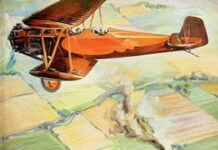1915
Fixed wing aircraft evolved steadily from experimental to a greater degree of certainty. The quality of innovation and designs improved, although it still remained an appendage to the main war effort. Notable events included marine-air partnerships, synchronised weapons, faster fighters and more effective bombers.
U12 German Submarine Plays Seaplane Ferry (January 1915)
German Submarine U12 was a conventional attack submarine, laid down in 1912. However in early 1916 the admiralty decided to lash a Friedrichshafen FF.29 seaplane to her deck, and ferry the aircraft on the surface to within close range of England to increase active flying endurance.
The technology involved partly submerging the submarine on arrival, and then releasing the seaplane so it could float clear and take to the air. The return journey would be the reverse of that, whereafter another flight could take place after refueling.

http://www.theaerodrome.com/forum/showthread.php?t=70461
Submarine U12 left the occupied Belgium port of Zeebrugge on January 15, 1915. However, once they left the breakwater the captain feared a heavy swell might swamp the aircraft, and ordered an immediate launch. The pilot crossed the channel and flew along the English coastline undetected, before returning safely to Zeebrugge.
The Friedrichshafen FF.29 was a lightweight two-seat tractor floatplane first launched in 1910, and produced by Flugzeugbau Friedrichshafen. Only 5 of that model were produced. The military used them for coastal patrols, and reconnaissance with the ability to carry small loads of bombs.
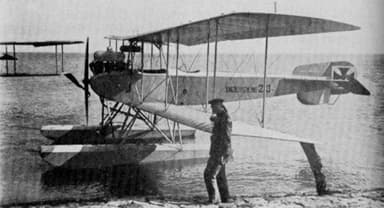
https://alchetron.com/Friedrichshafen-FF.29
The specification of the aircraft was as follows:
- Length 34 ft, wing span 53 ft, wing area 619 sq ft
- Empty weight 2,046 lb, gross weight 3,086 lb, crew 2
- Mercedes D.II inline piston engine, 120 hp
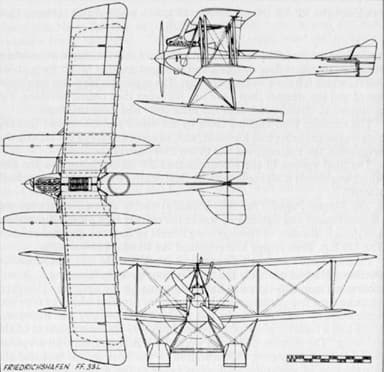
Image Source
Siemens Rotary Engine Flies in Siemens-Schuckert B (Early 1915)
The Siemens-Schukert company entered the world of military flight in early 1915, with its B-Type ‘Bulldog’ series fighter. This was a two-seater, unarmed reconnaissance biplane using tubular wing spars. Unfortunately it crashed during testing, but the parts were recycled for the similar Model E that followed.
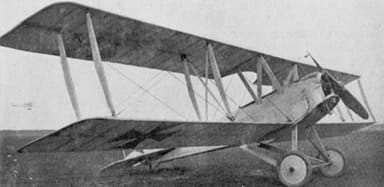
http://flyingmachines.ru/Site2/Crafts/Craft30298.htm
The Siemens-Schuckert E.1 was a more successful version with wire-braced wings, and a Siemens Halske Sh.I rotary engine. It first flew in late 1915, after which the military purchased 20 production models following successful evaluation.
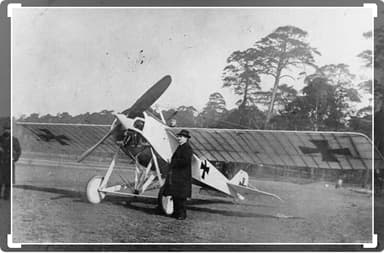
https://za.pinterest.com/pin/355151120593086923/
The specification of the E.I version was as follows:
- Length 23 ft, height 9 ft, wingspan 32 ft, empty 1,041 lb, gross 1,481 lb
- Max speed 87 mph, endurance 1 hr 30 min, 1 crew member
- Siemens-Halske Sh.I 100 hp engine, IMG 08/15 machine gun

https://www.bungartz.nl/siemtuig_d.html
Imperial Russian Navy Seaplane Carrier Enters Service (Feb 1915)
Russia commissioned its soleWorld War 1 seaplane carrier, Orlitza on February 2, 1915. She was a converted freighter with a flight deck added over the stern, and carried 4 to 5 seaplanes for operation in the Baltic Sea.
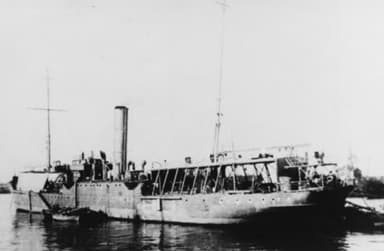
https://weaponsandwarfare.com/2020/09/15/imperial-russian-navy-seaplane-carriers/
Russian Battleships ‘Play Second Fiddle’ to Aviation (March 1915)
Heavy armor dominated the Black Sea during the Dardanelles Campaign, when Russians and Ottomans locked horns with battleships. On February 1, 1915 Britain’s first seaplane carrier Ark Royal set sail from Harwich, UK with 10 aircraft on board to support the Russian effort.
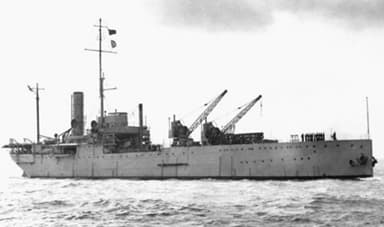
https://navalairhistory.com/2012/10/11/the-unsung-ark-royal/
The seaplanes included four Sopwith SS3 Scouts, and three 100hp Sopwith Type 807 folder floatplanes,along with two much larger Wight Pushers, and a 52 ft span Short Type 135.
Aerial raids continued through May, 1915. This was the first occasion that battleships played a secondary role while operating with aviation ships. It can be argued this military action foreshadowed the aircraft carrier-battleship task forces of World War II.
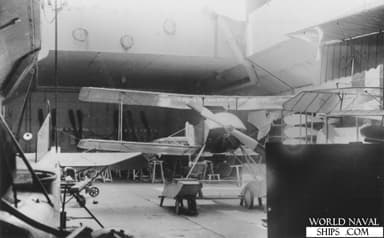
https://www.battleships-cruisers.co.uk/ship_photo.php?ProdID=104821
First Flight of Grigorovich M-5 Seaplane (Spring 1915)
The Grigorovich M-5 seaplane (alternatively Shch M-5 or Shchetinin M-5) was a successful Russian two-bay, unequal-span biplane flying boat with a single step hull. It was a product of the Grigorovich design bureau responsible for many other military aircraft.
It was also the first mass-produced flying boat built in Russia, and sold 300 models mainly to the Imperial Russian Navy, and the Finnish Air Force. Some continued flying until the 1920’s, proof of solid construction by the Shchetinin aviation company.
https://en.wikipedia.org/wiki/File:Grigorovich_M-5.jpg
The specification of the aircraft was as follows:
- Length 28 ft, height 10 ft, wing span 44 ft, wing area 400 sq ft
- Empty weight 1,445 lb, max take off 2,116 lb, crew 2
- Gnome Monosoupape 9 Type B-2 air-cooled rotary piston engine,101 hp
- Max speed 65 mph, endurance 4 hr, ceiling 10,800 ft
- Rate of climb 364 ft per min, time to altitude 3,200 ft in 10 min

https://www.aerialvisuals.ca/AirframeDossier.php?Serial=164583
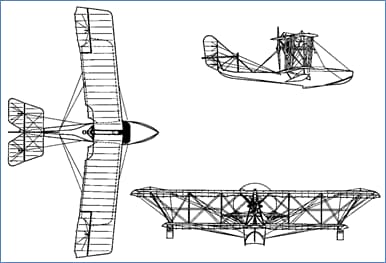
http://www.aviastar.org/air/russia/grigorovich_m-5.php
Pilot Imagination Knows No Bounds (March / April 1915)
The rate of fighter skirmishes and bombing raids ticked up, although these related more to the history of war and not the development of flight itself. A few incidents are worthy of mention though, for they demonstrate some early pilots were still largely free of top-down military control.
Alexander Kazakov
Imperial Russian Air Service Stabskapitän Alexander Kazakov used a grapnel to hook his aircraft to a German Albatros two-seater aircraft in mid-air on March 18, 1915, because his aircraft of an unknown type did not have a machine gun.
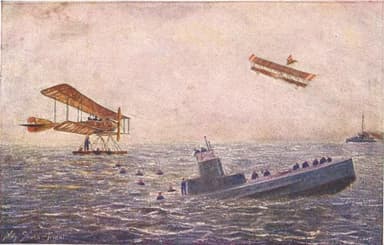
https://za.pinterest.com/pin/547046685961954082/
He had intended to blow the Albatros out the air by detonating a small bomb attached to the grapnel. However, he attacked the Albatros with his landing gear when this method failed, and downed the enemy aircraft surviving a rough landing himself.
Roland Garros
On April 1, 1915 French pilot Lieutenant Roland Garros fired a machine gun through his tractor propeller, and brought down a German Albatros observation plane.
Synchronization gear was not available at that time, although he was working on a design. However, he solved the problem by attaching metal deflector wedges to slightly narrowed propeller blades on his Morane Saulnier L biplane fighter

https://en.wikipedia.org/wiki/Morane-Saulnier_L#/media/File:Morane-Saulnier-L-airscrew-with-deflector.jpg
First Catapult Launch from a United States Vessel (April 1915)
United States turned its attention to fixed wing catapult-launches in 1915. Mastering the technology would be essential, were it to deploy conventional aircraft in naval battles.
Accordingly, it repurposed Coal Barge No. 214 which would have customarily been used for refueling naval vessels at Key West, and fitted it with an aircraft catapult and guiding track. The barge weighed 250 pounds, and measured 100 by 30 feet.

https://www.navalhistory.org/2019/11/07/the-coal-barge-at-the-cradle-of-naval-aviation
The first successful U.S. catapult launch took place on April 16, 1915 from Navy Coal Barge 214 at Naval Air Station Pensacola, Florida. Lieutenant (Junior Grade) Patrick N.L. Bellinger, who later rose the rank of vice admiral had been partying the night before and some say was under the weather.
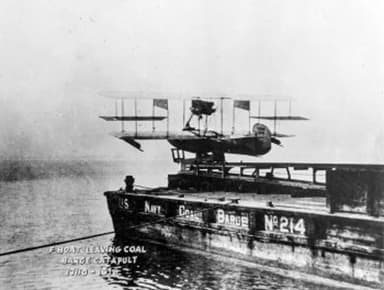
https://www.navalhistory.org/2019/11/07/the-coal-barge-at-the-cradle-of-naval-aviation
However the moment came to the man as he gunned the motor on his Curtiss Model F (AB-2) flying boat. The coal barge pointing into the wind made an effective launching platform. After the catapult fired there was a glorious feeling he later recalled. ‘Everything worked beautifully. As soon as I was in the air, I was a well man.’
The Zeppelin Staaken Riesenflugzeuge Giant Bomber (April 1915)
Giant, multi-engine bombers capable of reaching long distances were a feature of German aviation strategy. Count Ferdinand von Zeppelin may have intended his ‘fixed-wing zeppelins’ to strike terror in the enemy as they unleashed hails of bombs. The first of 37 Zeppelin Staaken Riesenflugzeuge (R) biplanes produced, made its maiden flight on April 11, 1915.
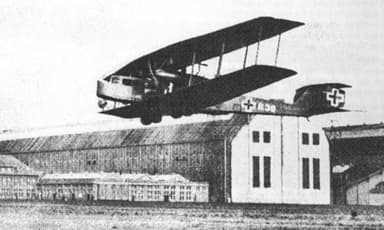
https://en.wikipedia.org/wiki/File:Zeppelin-Staaken_R.VI_photo1.jpg
The first Zeppelin Staaken R‘s came from Gothaer Waggonfabrik, which also produced small biplanes during World War 1. The giant Zeppelin bomber, on the other hand boasted a 138-foot wingspan, with four-bay inter plane-struts per half wing.
The two pusher-puller engine combinations were mounted in nacelle housings suspended between these biplanes, and also provided accommodation for engineers and / or gunners.
Other unusual features included an optional fifth, tractor motor in the nose, a box-like tail element with biplane tail-planes and twin fins with rudders, and a tricycle undercarriage allowing the aircraft to stand nose up or tail down onto a skid;
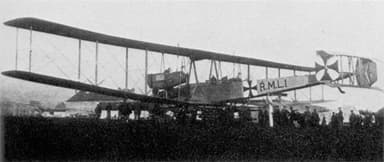
https://en.wikipedia.org/wiki/File:Zeppelin-Staaken_VGO-I.jpg
The square-section wood, or plywood fuselage curving up at the nose housed the rest of the crew, plus defensive armament positions, cockpit, cabin, and bomb load. But the paired engines amidships were in semi-stressed nacelle housings, with cockpits for engineers and defensive gunners according to the push / pull configuration.
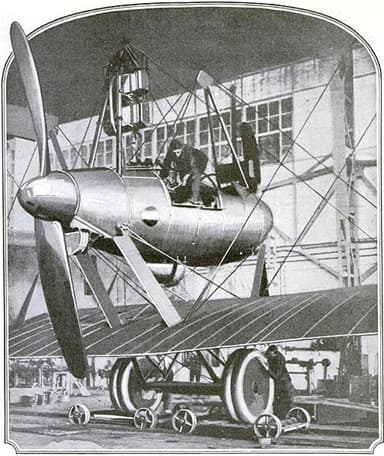
https://commons.wikimedia.org/wiki/File:Zeppelin-Staaken_R.XVI.jpg
The German Air Force deployed the giant bombers over the eastern and western fronts, as well as for strategic bombing of targets in England and France. A number of different versions followed through to 1919. However, the Treaty of Versailles put a stop to further development.
The specification varied, but was generally similar to this R.VI version:
- Length 72 ft, height 21 ft, wing span 138 ft, wing area 2,595 sq ft
- Empty weight 14,426 lb, gross weight 26,066 lb, crew seven
- 4 × Maybach Mb.IV 6-cyl engines in-line, 245 hp each
- Max speed 89 mph, endurance 7 hrs, service ceiling 14,710 ft
- Armament 6 x lMG 08 7.92-mm machine guns, 4,400 bomb load
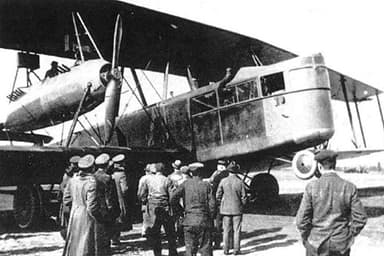
https://www.wikiwand.com/en/Zeppelin-Staaken_R.XIV
SPAD S.A.2 With an Unorthodox Position for Observer (May 1915)
The French SPAD Société Pour L’Aviation et ses Dérivés was active in aircraft manufacture between 1911 and 1921. It produced a two-seater tractor biplane named SPAD S.A.2, that France and Russia deployed in early stages of the war for fighter and reconnaissance purposes.
Its design was somewhat unusual in that it carried its observer-gunner in a nacelle ahead of its engine, propeller, pilot and wing. The rationale was to give the observer a clear field of view to the front and sides, without the drag penalty of a typical pusher biplane. A British evaluation suggested ‘it would be expensive in observers if flown by indifferent pilots’.
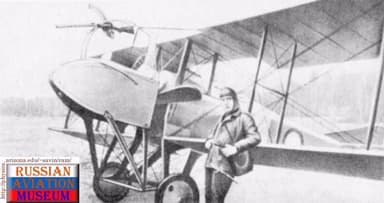
http://www.ram-home.com/ram-old/spad-sa2.html
This arrangement had clear advantages for nations lacking access to synchronization gear, by allowing shooting ahead of the propeller. The ad-hoc plan allowed the forward nacelle to hinge down for maintenance. The gunner-observer had a mesh screen behind them to avoid striking their head on the propeller. However, the aircraft was not an overall success.
The specification was as follows:
- Length 26 ft, height 8 ft, wing span 31 ft, wing area 273 sq ft
- Empty weight 913 lb, gross weight 1,486 lb, crew two
- Le Rhône 9J 9-cylinder air-cooled rotary piston engine, 110 hp
- Max speed 87 mph, endurance 3 hours, time to 10,000 ft, 23 min
- .303 inch light aircraft machine gun (Lewis, Colt, Hotchkiss or Madsen)
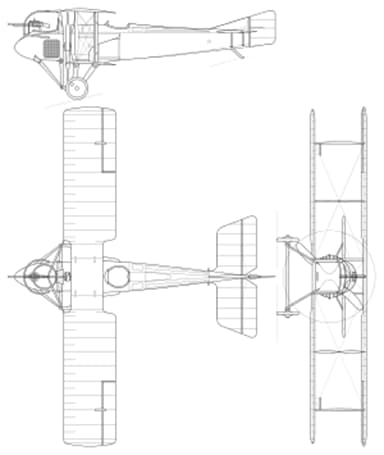
https://en.wikipedia.org/wiki/File:SPAD_SA.2.svg
Fokker Production Prototype Shifts Boundaries (July 1915)
The Fokker Eindeckers were a series of German single-seater, tractor monoplanes fitted with the first synchronization gear. This enabled them to fire their Parabellum MG 14 machine guns through the arcs of their propellers, without striking their blades as they zoomed down on their enemy from the rear.
This technological breakthrough gave the Germans military air superiority from July 1915 until early 1916. The effect on Allied aviators was devastating. They regarded their less-effective aircraft as ‘Fokker Fodder’ for the ‘Fokker Scourge’.

https://en.wikipedia.org/wiki/File:Fokker_M5K-MG_E5-15.jpg
German Leutnant Kurt Wintgens took to the air in one of five E.5/15 Fokker M.5K/MG prototypes on July 1, 1915. He downed a Morane-Saulnier L two-seat ‘parasol’ observation aircraft over the Western Front that day. Then he shot down two more Morane Type L two-seaters, one each on July 4 and 15 in the same E.5/15 Fokker M.5K/MG prototype.
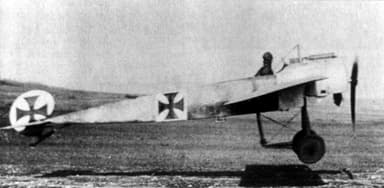
https://en.wikipedia.org/wiki/File:Fokker_Eindecker_takeoff_profile_view.jpg

https://en.wikipedia.org/wiki/File:Fok_E_I%27s_U-0_%26_Stangensteuerung.jpg
The specification of the E.III version was as follows:
- Length 23 ft, height 8 ft, wing span 31 ft. wing area 170 sq ft
- Empty weight 880 lb, gross weight 1,345 lb, crew one
- Oberursel U.I 9-cyl.air-cooled rotary piston engine, 100 hp
- Max speed 87 mph, range 123 mi, endurance 1.5 hrs
- Service ceiling 11,810 ft, 3,200 ft in 5 min, 9,800 in 30 min
- 0.312 in lMG 08 Spandau offset synchronised machine gun

Location of Image
The Airco D.H.2 Allied Pusher Biplane Stalwart (July 1915)
Aeronautical engineer Geoffrey de Havilland designed the Airco D.H.2 for the Aircraft Manufacturing Company, as Fokker grasped for aerial superiority with synchronization gear. It became the first effectively-armed British single-seat fighter, enabling its pilots to counter theatthreat in the sky.

https://en.wikipedia.org/wiki/File:Airco_DH2_2.jpg
De Havilland based his design on a smaller version of his Blériot Scout B.S.1. Early experiences on the Western Front proved the need for forward-firing aircraft. The solution turned out, after several experiments, to be a fixed forward mount at the front of the fuselage so the pilot could ‘aim with his aircraft’.
The design incorporated aileron controls on the upper and lower wings, which returned to neutral when the control relaxed. Later models had gun and ring sights to help the pilot allow for leading a target in which he shot slightly ahead of it. The B.S.1’s first flight was in July 1915. By 1916, there were 7 fighter squadrons on the Western Front proving a match for the German Fokker Eindecker.
https://en.wikipedia.org/wiki/Airco_DH.2#/media/File:Airco_D.H.2_ExCC.jpg
The specification of the aircraft was as follows:
- Length 25 ft, height 10 ft, wing span 28 ft, wing area 249 sq ft
- Empty weight 943 lb, gross weight 1,441 lb, crew one
- Gnôme Monosoupape 9-cylinder rotary engine, 100 hp
- Max speed 93 mph, endurance 2.45 hrs, ceiling 14,000 ft
- Time to altitude 10,000 ft: 24 minutes, 45 seconds
- Armament .303 inch Lewis gun with top mounted pan
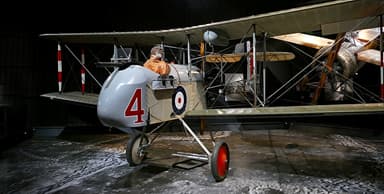
https://en.wikipedia.org/wiki/File:Airco_De_Havilland_DH_2._(31141486647).jpg
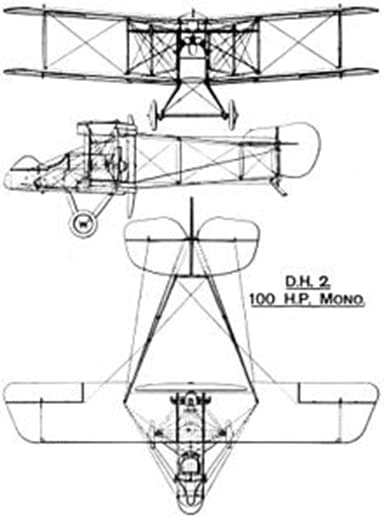
https://en.wikipedia.org/wiki/File:Airco_D.H.2_British_First_World_War_single_seat_fighter_rigging_drawing.jpg
British Seaplane Takes off With Wheeled Floats (August 1915)
HMS Campania was a seaplane tender and aircraft carrier converted from an aging 1893 passenger liner on the Liverpool – New York service. She had already gone to the breakers yard when the British navy purchased her, and converted her to an armed merchant cruiser.
However, plans changed when she reconverted to an aircraft carrier shortly afterwards. This involved removing the two forward 4.7-inch guns in favor of a 160-foot flying-off deck. There were two handling derricks on either side, an amidships hold for seven large seaplanes, and a forward hold beneath a removable desk for four smaller ones.
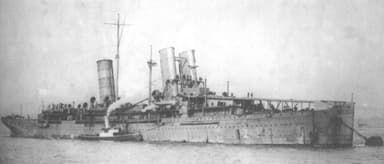
https://en.wikipedia.org/wiki/File:HMS_Campania_1.jpg
On August 2, 1915 a Sopwith Baby Type 8200 seaplane took off from Campania’s flight deck using floats with beaching wheels fitted. This was the first time an aircraft took off from a platform aboard a fully operational British aviation ship.
The Type 8200 Sopwith Baby seaplane was a variant of the two-seat Sopwith Schneider that won that trophy in 1914. It had a conventional wooden structure covered over with fabric, and a Lewis gun either above the fuselage for firing through the propeller, or on the top wing above it.
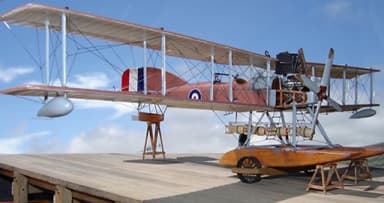
http://hsfeatures.com/features04/short184jf_2.htm
The specification of the aircraft was as follows:
- Length 23 ft, height 10 ft, wing span 25 ft, wing area 240 sq ft
- Empty weight 1,226 lb, gross weight 1,715 lb, crew one
- Clerget 9Z 9-cylinder air-cooled rotary piston engine, 110 hp
- Max speed 100 mph, endurance 2 hours, ceiling 10,000 ft, 285 ft/min
- Armament Lewis gun, 2 × 65 lb bombs

https://en.wikipedia.org/wiki/Sopwith_Baby#/media/File:Sopwith_Baby_dwg.jpg
First Successful Air-Launched Torpedo Attack (August, 1915)
British naval pilot Charles Edmonds launched the first air-to-sea torpedo attack on August 14, 1915 during the Dardanelles Campaign. He launched his Short Type 184 biplane from converted packet steamer Ben-My-Chree.
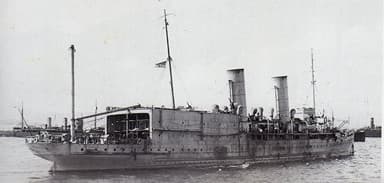
https://en.wikipedia.org/wiki/File:Stern_of_HMS_Ben-my-Chree.jpg
TheTurkish 5,000 ton supply ship subsequently sank, although it had already been hit by a British submarine. However, Charles Edmonds successfully attacked, and sank another Turkish ship five days later.
He subsequently remarked ‘The feat is all the more remarkable because the weight of the torpedo means that the Short Seaplane can only get into the air with a perfect combination of calm seas, light breezes and an engine running to its absolute limits, giving the aircraft an endurance of only about 45 minutes.’

https://en.wikipedia.org/wiki/Short_Type_184#/media/File:Short_184.jpg
First Sustained Aerial Bombing Raid (August 1915)
The Italian air force launched a bombing raid on targets at a military airbase in Austria-Hungary on August 20, 1915. This was the first full-blown event, with a number of aircraft involved. The airbase was near the strategically-important village of Aisovizza (Ajševica) in Slovenia.
The action occurred shortly after the Caproni Ca.1 heavy bomber entered service. They were three-engine biplanes, of fabric-covered wooden construction incorporating twin tail booms. Crew included two pilots, a front gunner, and a rear gunner-mechanic who manned upper machine guns from a protective cage just in front of the rear propeller.

https://en.wikipedia.org/wiki/File:Caproni_Ca.32(300hp-Ca.2)_with_Gianni_Caproni_on_board.jpg
The aircraft was an operational success, with the Italians equipping 15 bomber squadrons with Ca.1, Ca.2, and Ca.3 variants. Some Ca.1s survived the war to be rebuilt as Ca.56 airliners able to carry up to six passengers.
https://www.militaryfactory.com/aircraft/detail.asp?aircraft_id=774
The specification of the aircraft was as follows:
- Length 36 ft, height 12 ft, wing span 74 ft, wing area 1,029 sq ft
- Empty weight 7,264 lb, gross weight 8,800 lb, crew four
- Three 80 hp Gnome rotary engines in tractor / pusher combination
- Max speed 75 mph, range 344 mi, service ceiling 13,120 ft
- Two × 6.5 mm FIAT-Revelli machine guns, bombs held under hull
Russia Deploys Seaplane-Carrier Battleship Force (October 1915)
Fixed wing aircraft continued to play a low-profile role in the skies over the battlefields of Europe. The main action came from Germany’s lighter-than-air zeppelins that continued to harass London, with limited effect apart from the psychological impact.
The Russian navy attacked the Bulgarian Black Sea port of Varna with a combined seaplane carrier and battleship fleet on October 27, 1915. This was after Bulgaria entered the war on the side of Germany, Austria-Hungary and the Ottoman Empire
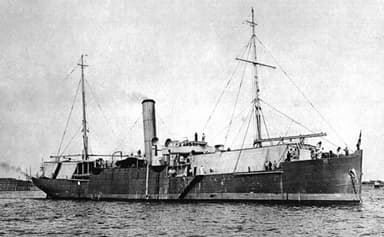
https://www.rbth.com/history/330206-how-russian-empire-lost-all
Seven seaplanes launched in the course of the battle, hoping to damage German submarines stored at Varna. However, rough seas hampered the effort, which attracted an unsuccessful German seaplane counter attack against the Russian battle fleet.
Aircraft Assume Aggressive Role Over Ground Fighting (Oct 1915)
Battles raged on the Austria-Hungary border after Italy entered the war. However, it would take almost a year before Italy pushed its enemy back decisively. On October 18, 1915 it deployed a squadron of its aircraft to launch their first contribution.
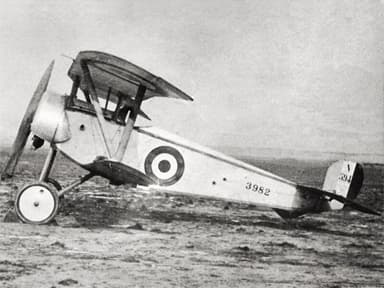
https://en.wikipedia.org/wiki/Nieuport_11#/media/File:Nieuport_11_of_the_Escadrille_Am%C3%A9ricaine_flown_by_Sgt_Douglas_Mac_Monagle.jpg
The Italian aircraft included Nieuport fighters, with which one of Italy’s greatest fighter aces Giannino Ancillotto scored four aerial victories over the front the following year.

https://weaponsandwarfare.com/2015/12/25/the-italians-enter-wwi/
Siemens-Schuckert R.II With Forked Rear Fuselage (October 1915)
The Siemens-Schuckert R.II was one of six German variants based on the Siemens-Schuckert R.I prototype, and intended for the large bomber stable. It was distinguished by a fully enclosed cabin, and an unusual fuselage forked into an upper and lower section, to provide a clear field of defensive fire towards the rear.
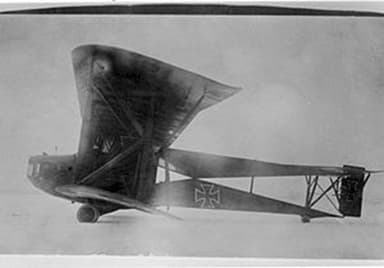
https://en.wikipedia.org/wiki/Siemens-Schuckert_R.II
The large, three-bay biplane with un-staggered wings of unequal span had three engines internally in the fuselage. These supplied power to two propellers mounted tractor-fashion on the inter-plane struts nearest the fuselage. Two divided undercarriage units each carried two wheels, supplemented by two wheels at the tail.
The Maybach engines proved troublesome with overheating and mechanical failure during the first flight on October 26, 1915. Following much discussion, the developer substituted three, heavier Mercedes D.IVa power plants, after installing three extra sections in the wing to extend it to six bays.
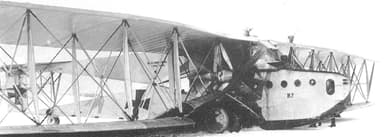
https://riseofflight.com/forum/topic/34585-world-war-one-planes/page-2
However, the giant bomber was still not a success, being unable to keep pace with other versions because of increased wing span and weight. Riesenflugzeug Schulabteilung giant aircraft training unit assigned it to training duties. However, it crashed the following year at its Cologne base.
The specification of the adapted version was as follows:
- Length 60 ft, height 15 ft, wing span 124 ft, wing area 2,516 ft
- Empty weight 13,540 lb, gross weight 18,612 lb, crew five
- Three Mercedes D.IVa 6 cylinder inline 260 hp engines
- Maximum speed 69 mph, endurance 4 hours

https://en.wikipedia.org/wiki/Mercedes_D.IVa#/media/File:Daimler_D_IV.jpg
Conventional Wheeled Aircraft Takes off from Warship (Nov 1915)
Flight Sub-Lieutenant Harold Towler made history when he launched his wheeled Bristol Scout aircraft from the deck of a British warship on November 3, 1915. This opened up new possibilities for naval aerial attacks, previously reserved for sea planes that could land in water for recovery.
HMS Vindex was a modified fast passenger ferry built in 1905. The admiralty modified her by adding a 64-foot-long flying-off deck forward, specifically intended for aircraft with wheeled undercarriages, and added a storage hangar aft.
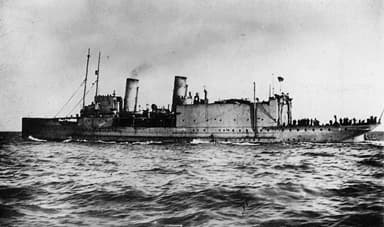
https://en.wikipedia.org/wiki/File:HMSVindex1915.jpg
HMS Vindex had two electric cranes for handling a load of seven aircraft. When first recommissioned these included five seaplanes in the rear storage hangar – and two disassembled in the smaller forward hangar that could be reassembled and flown off in ten minutes.
https://za.pinterest.com/pin/337347828320929934/
HMS Vindex was steaming at twelve knots when Flight Sub-Lieutenant Harold Fowler took off from the forward deck between the superstructure and the bow. His Bristol Scout lifted off on the steady breeze, and landed later at the naval base at Great Yarmouth.
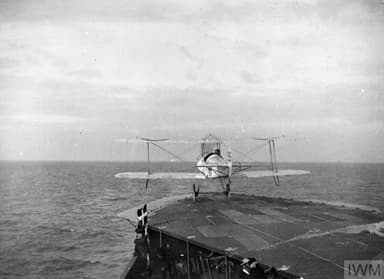
https://en.wikipedia.org/wiki/HMS_Vindex_(1915)#/media/File:Flt_Lt_Towler_makes_the_first_take-off_from_a_carrier_ship_the_HMS_Vindex_1915.jpg
First Catapult Launch from a Warship (November, 1915)
A catapult launch from a ship would have distinct advantages over a conventional flight platform, because it required less deck. On November 5, 1915 Lieutenant Commander Henry C. Mustin catapulted his Curtiss AB-2 (previously Model F) flying boat off the stern of United States Navy armored cruiser USS North Carolina.
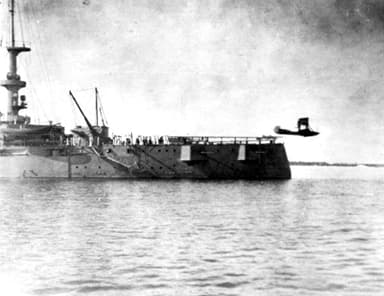
https://en.wikipedia.org/wiki/File:MustinCatapult1915.jpg
Halberstadt D.II Maintains German Air Superiority (Late 1915)
Halberstädter Flugzeugwerke was initially a British-German joint venture, although it broke away in 1913. Its Halberstadt D.II fighter biplane helped maintain German air superiority through to 1916, when superior Albatros fighters took over in the second half of that year. But use of small numbers continued well into 1917.
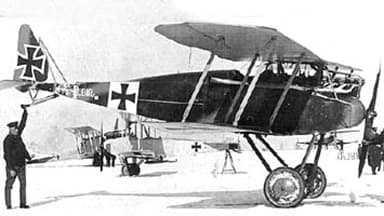
http://www.pilotfriend.com/photo_albums/timeline/Halberstadt%20D.II.htm
The Halberstadt D.II logged several firsts for the German air force. It was the first biplane-configuration fighter aircraft to serve in combat for the German Empire, and served as a test bed for wing-mounted rockets in 1916. Then in 1917 it participated in combat trials using radio communications.
Much effort was taken to lighten the load compared to the earlier Halberstadt D.I experimental version. Other modifications included staggered wings with a lower, ‘trailing edge droop’, and a more powerful 120 hp Mercedes D.II engine. The aircraft was able to dive steeply while firing a single synchronized lMG 08 Spandau machine gun through the propeller arc.
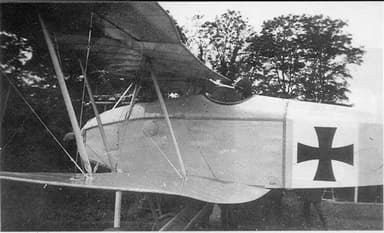
https://en.wikipedia.org/wiki/File:Halberstadt_D.II_drooped_lower_trailing_edge-1.jpg
This aircraft first flew in late 1915, and entered service in February 1916. Halberstädter Flugzeugwerke manufactured a total 60, regarded as the ‘best available fighter’ at the time. Various aces used it to demonstrate their pioneering air fighting tactics, and exceptional flying skills.
The specification of the aircraft was as follows:
- Length 23 ft, height 8 ft, wing span 28 ft, wing area 254 sq ft
- Empty weight 1,144 lb, gross weight, 1,606 lb, crew one
- Mercedes D.II 6-cyl. water-cooled in-line piston engine, 120 hp
- Max speed 93 mph, range 130 mi, ceiling 13,000 ft
- 3,200 ft in 3.5 min, 6,600 ft in 6.5 min, 10,000 ft in 14.5 min
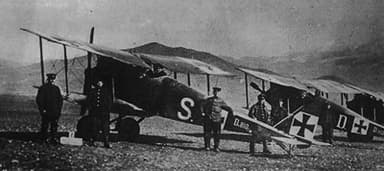
http://www.histomin.com/HM%20Journal/HMJ%20Journal%20Issue%2002/HMJ02%20Aircraft%20-%20Halberstadt%20DII/HMJ%20Issue%2002%20Halberstadt%20D.II.htm
First Practical All-Metal Aircraft Takes a Hop (Dec 1915)
The Junkers J1 all-metal aircraft may not have been the resounding success aeronautical designer Hugo Junkers envisaged. However, it would probably still be an icon in the history of flight, had an Allied bombing raid not destroyed the sole intact example at the Deutsches Museum in Munich during December 1944.
Earlier aircraft designers had experimented with metal frames, however this time Hugo Junkers sheathed the surfaces in metal too, achieving an air-slippery smoothness that forecast the future of flight.
Unfortunately its performance was disappointing, leading to contemporary pilots describing it as the ‘blechesel’ sheet metal donkey. The fundamental problem was sheet metal was too heavy for a favorable power to weight ratio given available engines.

https://en.wikipedia.org/wiki/File:Junkers_J_1_at_D%C3%B6beritz_1915.jpg
The Junkers J 1 was an experimental, mid-wing airplane with a cantilever wing, and clean proportions. Seventeen-inch steel panels over the frame formed the first example of an all-metal stressed-skin. Smooth sheets of metal also covered the wings and the tailplane.
Static test completed on December 3, 1915, whereafter the aircraft was transported to the Döberitz airfield just west of Berlin. On December 12, 1915 Leutnant Theodor Mallinckrodt was assigned to taxi the experimental aircraft, whereafter he achieved a 10 ft hop into the air.
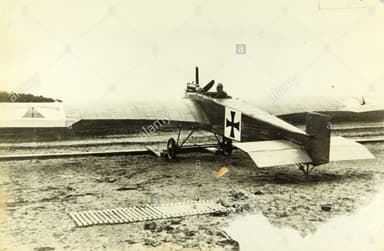
https://www.alamy.com/stock-photo-junkers-j1-54106433.html
Several iterations and experiments followed. Then on January 18, 1915 Leutnant Mallinckrodt achieved an altitude of 3,000 ft. He reported inflight handling was acceptable and Junkers 1 was stable.
Then he took the experimental aircraft for a four-mile flight the following day, at altitudes ranging between 660 and 980 ft. At one stage he achieved a reputed speed of 107 mph. The military remained supportive despite technical criticism from those on the ground, and commissioned Hugo Junkers to continue his work.

https://utd-ir.tdl.org/handle/10735.1/1296
The specification of the aircraft was as follows;
- Length 28 ft, height 10 ft, wing span 42 ft, wing area 262 sq ft
- Empty weight 2,028 lb, gross weight 2,381 lb, one crew
- Mercedes D.II 6-cyl. water-cooled in-line piston engine, 120 hp
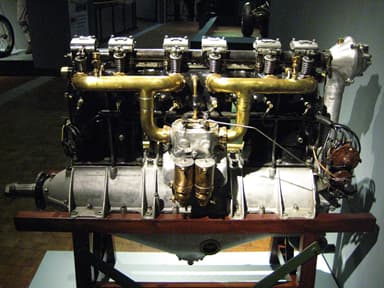
https://en.wikipedia.org/wiki/Mercedes_D.II#/media/File:Daimler_D_II.jpg
1916
SUMMARY
Fixed wing aircraft continued settling into their new role as weapons of war, while pilot skills improved and command matured. This included new strategies deploying aircraft as teams as opposed to independent individuals. Germany entered the year with aerial superiority, but steadily lost it in the face of improving Allied Aircraft.
JANUARY
- British Royal Flying Corps risked 10 of its 16 aircraft against a German attack across the Channel. They lost three pilots over an evening. They learned their lessons and invested more in training.
- Britain could not sustain ongoing losses to German Fokker Eindecker fighters. The Royal Flying Corps introduced an escort of at least three fighters flying in close formation with reconnaissance planes.
- Germany continued responding with large groups of zeppelin dirigibles crossing the Channel to England, against which British aircraft appeared helpless. Their only salvation was zeppelins generally missed their targets.
FEBRUARY
- The German Army air service adopted a strategy of separate, single-seat fighter squadrons. Its goal was to deploy them as ‘aerial guard units’ along the Western Front.
- A group of seaplanes from the Imperial Russian Fleet in the Black Sea sank a 4,211-ton Ottoman collier while it was serving as a German naval transport.
- Germany deployed 168 aircraft as the Battle of Verdun commenced. Future French ace Jean Navarre turned his Nieuport 11 Bébé fighter into a propaganda machine by painting it in French red, white and blue.
MARCH
- Groups of British fighters teamed with anti-aircraft guns on the ground, to tackle a determined attack on London by seven German zeppelins. They damaged one severely and it crashed off the coast of England.
APRIL
- British aircraft delivered 13 tons of stores to Kut el Amara, Mesopotamia – now an Iraqi city – besieged by Turkish forces. This was the first time aircraft were used in this way.
- The American Squadron – later known as the Lafayette Squadron – established in France as an American volunteer unit equipped with Nieuport 11s.
Hansa-Brandenburg D.I Flies Despite Poor Handling (Autumn 1916)
The Hansa-Brandenburg D.I was a German biplane fighter aircraft, of which many of the 122 produced saw service with Austria-Hungary. That it made production may suggest ‘beggars perhaps could not be choosers’. Despite this, some survived to see the war to conclusion, arguably because of 116 mph top speed.
https://en.wikipedia.org/wiki/File:Hansa_Brandenburg_D.I.jpg
Ernst Heinkel chief designer of the Hansa und Brandenburgische Flugzeug-Werke developed the KD (Kampf Doppeldecker as it was also called) to meet the requirements of the Austro-Hungarian Air Force. It was a single-seat, single engine biplane of wooden construction, with plywood fuselage skinning and fabric covering wings.
Four ‘V’ interplane struts fabricated from steel tubes joined in the center of each wing, forming an unusual star-shaped effect. However, the deep fuselage afforded a poor view to the front, and tended to ‘blanket’ the small rudder. As a result, lateral stability was poor, and recovery from spins extremely difficult.
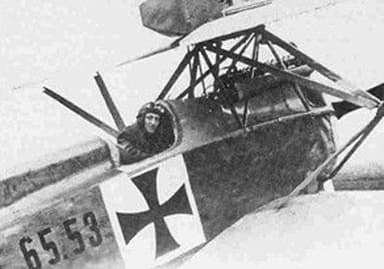
https://www.pinterest.dk/pin/112660428158813740/
Ernst Henkel developed the aircraft in the course of 1916, and it entered service in autumn of that year. It became the standard Austrian-Hungarian fighter aircraft until mid-1917, although use continued until the end of the war. Several Austro-Hungarian air aces including Godwin Brumowski and Frank Linke-Crawford flew it.
The specification of the Hansa-Brandenburg D.I was as follows:
- Length 21 ft, height 9 ft, wingspan 28 ft, wing area 256 sq ft
- Empty weight 1,482 lb, gross weight 2,028 lb, one crew member
- Austro-Daimler 185hp 6-cylinder water-cooled in-line piston engine
- Max speed 116 mph, endurance 2.5 hrs, ceiling 16,000 ft, 3,300 ft in 3 min
- Single .315 inch Schwarzlose machine gun in fairing on upper wing
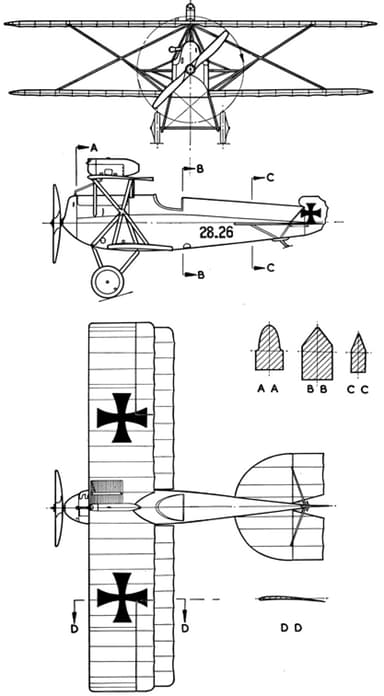
https://drawingdatabase.com/hansa-brandenburg-d-i/
Parasite Fighter Experiments Commence in Britain (May 1916)
Parasite aircraft launch from larger, airborne carrier aircraft. The first known successful example was on May 17, 1916, when Britain launched a Bristol Scout from a Felixstowe Porte Baby flying boat. The intention was to increase the flying range of fighters, by piggy-backing them on longer-range bombers forming composite aircraft.
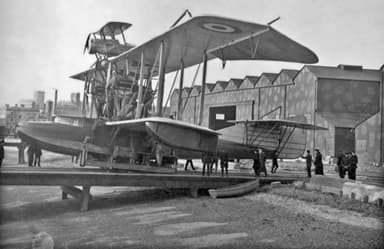
https://en.wikipedia.org/wiki/File:Bristol_Scout_on_Felixstowe_Porte_Baby_first_composite_aircraft_1916.jpg
The two aircraft successfully separated. The immediate intention was to intercept German zeppelins patrolling over the North Sea at high altitudes. However, subsequent success with launching aircraft from ships shelved the idea.
Fighters Down Balloons with Li Prieur Rockets (May 1916)
French Lieutenant Yves Le Prieur was an inventor and aviation pioneer who found himself in the midst of conflict. He came up with the idea of a plane-mounted rocket battery, able to bring down observation balloons. It proved remarkably effective, and only phased out after the arrival of tracer rounds and incendiary bullets for on-board machine guns.
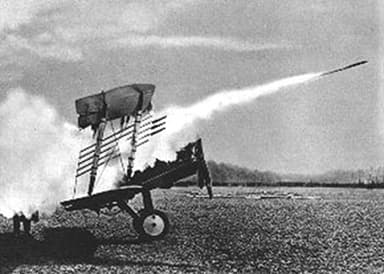
https://www.ctie.monash.edu/hargrave/le_prieur.html
The Le Prieur rocket was a cardboard tube filled with 200 grams of black powder, and a conical wooden head with a knife blade inserted. It fired electrically from the interplane struts supporting aircraft biplane wings. A cockpit switch launched all the rockets consecutively, often during a steep-inclined dive some 400 feet from target.
The first live attack occurred on May 22, 1916, when eight French pilots flying Nieuport 16s made an early morning attack that downed six German balloons. Other Allied aircraft equipped with these rockets included the B.E.2/B.E.12, Sopwith Baby/Pup/Camel, Nieuport 11/16/17, SPAD 7/13 and the Farman HF.20/21.
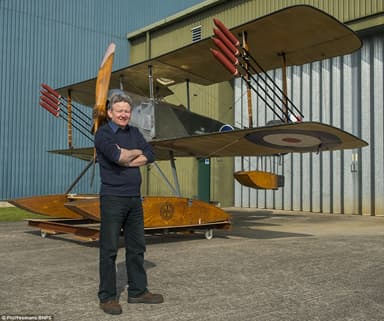
https://www.dailymail.co.uk/news/article-3516955/Glorified-fireworks-world-s-air-air-missile-recreated-100-years-used-protect-Britain-German-Zeppelin-airships.html
Aircraft Carrier Influences Mighty Battle of Battleships (May 1916)
The Battle of Jutland was the only full-scale battle of battleships during the war. Germany aimed to lure out, trap, and destroy a portion of the Britain’s Grand Fleet to break their blockade. There was no radar to scan the restless, heaving oceans. However, Britain had a strategic advantage.
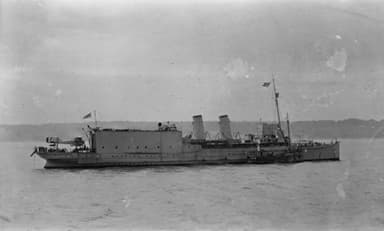
https://en.wikipedia.org/wiki/File:HMS_Engadine.jpg
HMS Endigane was a converted Channel ferry with temporary hangars for four seaplanes. One of her aircraft, a Short Type 184 made history on May 31, 1916 when it flew over the Jutland battle site, and spotted and reported three cruisers and ten destroyers of the German High Seas Fleet. The truth was out.
First Catapult Launch from Ship Underway (July 1916)
USS North Carolina was an armored cruiser commissioned in May, 1908. She was seconded to Pensacola Florida in June 1915 to conduct experiments with naval aviation.
On July 12 1916, Lieutenant Godfrey Chevalier successfully catapulted from the USS North Carolina foredeck at the controls of a Curtiss flying boat, while the giant ship was underway. This was the first catapult launch from a ship steaming ahead, and further proof of the feasibility of the idea.

https://commons.wikimedia.org/wiki/File:1916_catapult_launcher_on_USS_North_Carolina.jpg
Merging of Monoplane Design Matures (July 1916)
By mid-1916 there was growing consensus regarding the overall details of mono-fixed-wing aircraft design, at least among German and French aeronautical engineers. When an opposing one was brought down intact, they examined every detail in the ongoing battle for air superiority for which the stakes were high.
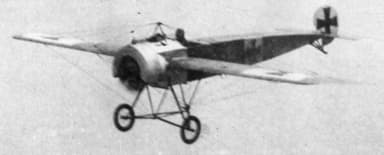
https://en.wikipedia.org/wiki/Fokker#/media/File:Fokker_EIII_210-16.jpg
Aircraft were also becoming faster and nimbler as ace pilots tested them to extremes. Inevitably, friendly fire brought down a few of them. Then on July 18, 1916 the French painted all their metal airplane parts red, including propeller spinners, interplane struts, and engine cowlings to avoid confusion.

https://commons.wikimedia.org/wiki/File:Morane-Saulnier_N.jpg
Single Tractor Engine Biplane Turns Zeppelin Tide (Sept 1916)
German zeppelin dirigible airships had eluded fixed wing aircraft since the war began. Small fighter airplanes and ground fire were proved largely ineffective. Sixteen German airships attacked southeast England on the night of September 2 – 3, 1916. They dropped 823 bombs causing significant damage.
In the midst of the confusion a Royal Flying Corps B.E.2 single-engine tractor two-seat biplane shot down a German Army Schütte-Lanz airship SL 11. This fell spectacularly over London killing all 16 crew.
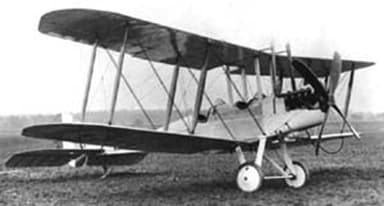
This incident had a far greater effect, when the German Army Airship Service withdrew from future bombing raids on England. They handed the task over to the German Navy, signaling a turning point in the air defense of England.
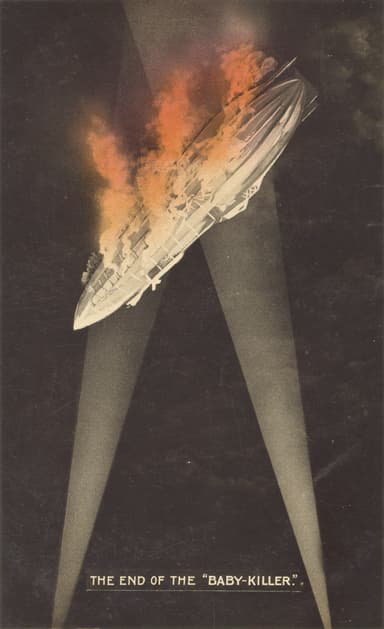
https://commons.wikimedia.org/wiki/File:The_End_of_the_%27Baby-Killer%27.png
First Successful Aerial Attack on Submarines (Sept 1916)
Two Austro-Hungarian Lohner-L flying boats departed on a scheduled sortie over the eastern Mediterranean on September 15, 1916. They paused at Venice to sink British submarine B10 at her mooring, where she was sheltering after an earlier seaplane attack.

https://en.wikipedia.org/wiki/Lohner_L#/media/File:Lohner_L.jpg
Then the two seaplanes crossed over the Adriatic Sea to Montenegro, where they sank French submarine Foucault off the coast near Cattaro. British B10 was the first submarine sunk by aircraft, while Foucault was the first one they sank at sea.
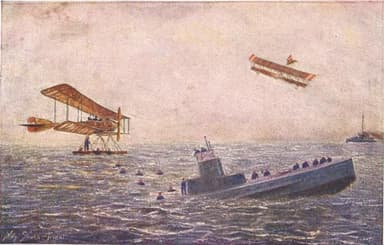
https://www.wingsofwar.org/forums/showthread.php?19689-100-Years-Ago-Today/page36&styleid=22
The specification of the Lohner-L seaplane was as follows:
- Length 33 ft, height 13 ft, wing span 53 ft, wing area 570 sq ft
- Empty weight 2,535 lb, gross weight 3,748 lb, pilot and observer
- Austro-Daimler 160hp 6-cyl. water-cooled in-line piston engine
- Max speed 65 mph, range 370 mi, service ceiling 8,200 ft
- Trainable machine gun for observer, 440 lb load of bombs
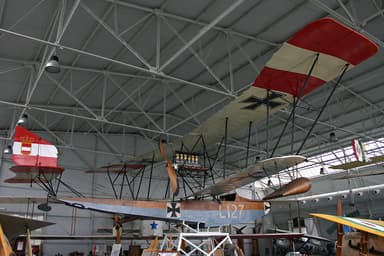
https://en.wikipedia.org/wiki/Lohner_L#/media/File:Lohner_L-1_L127_Mani_(6405508905).jpg
More Than 2,280 Biplane Trainers for Novice Pilots (Late 1916)
Prior to the de Havilland Airco DH.6, Allied air forces used obsolete airplanes to train novice pilots. Then in 1916 Britain decided it required a purpose-built trainer that was inexpensive, easy to build, and easy to repair after mishaps. The result was an ungainly-looking aircraft that forces christened with ribald names.
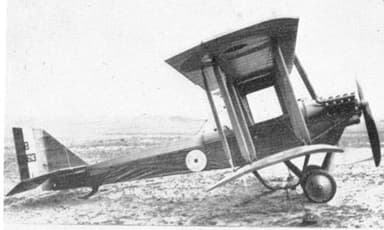
https://en.wikipedia.org/wiki/File:DH6SideView.jpg
The fuselage box made no attempt at refinement, or even creature comforts for instructor and student. The square cut wings were interchangeable, with no stagger and cables, nor wires bracing them. Even the fin and rudder were elementary. There was no cowling, just upswept exhaust pipes. The first of over 2,280 produced flew late in 1916.
Despite this, history records the DH.6 as ‘ladylike in the extreme’, and ‘utterly viceless’. It could remain airborne at speeds as low as 30 mph. However, the designers incorporated inherent instability, so it would be an efficient elementary trainer. Many survived the war to become leisure aircraft, sometimes with three passengers squeezed in.
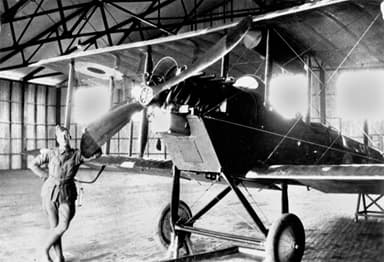
https://commons.wikimedia.org/w/index.php?search=airco+dh+6&title=Special%3ASearch&go=Go&ns0=1&ns6=1&ns12=1&ns14=1&ns100=1&ns106=1#/media/File:StateLibQld_2_149823_Mechanic_C._R._Wilson_with_a_De_Havilland_DH6_two-seater_biplane,_Point_Cook,_1918.jpg
The specification of the Airco DH.6 trainer was as follows:
- Length 27 ft, height 11 ft, wing span 36 ft, wing area 436 sq ft
- Empty weight 1,460 lb, gross weight 2,030 lb, instructor and student
- RAF 1a air-cooled V8 engine 90 hp, fuel capacity 30 US gal
- Max speed 70 mph, stall speed 40 mph, endurance 2.75 hours
- Armament 100 lb bomb or similar load of smaller bombs
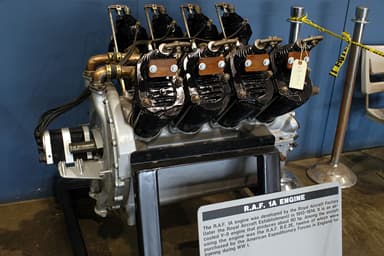
https://en.wikipedia.org/wiki/RAF_1#/media/File:R.A.F._1A_at_National_Museum_of_the_United_States_Air_Force.jpg
Three Crew for a New Series of Recon Bombers (Late 1916)
The Letord Let Series of three-seat reconnaissance aircraft developed into perhaps the most numerous stable of World War 1 bombers later. The story began in early 1916, when the French military decided contemporary aircraft including the Caudron G.6, Morane-Saulnier T and Salmson-Moineau SM.1 left much to be desired.
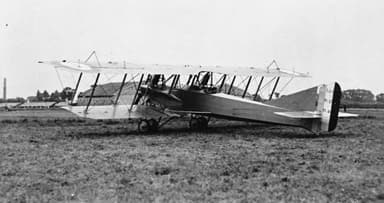
https://commons.wikimedia.org/wiki/File:French_Aircraft_of_the_First_World_War_Q66791.jpg
The Letord Let.1 and the seven variants that followed in 1917 were similar biplanes with unequal span or equal span wings, and prominent and characteristic negative stagger on them. Power came from two tractor engines in nacelles to either side of the fuselage, strut-mounted on the lower wings.
The pilot sat in an open cockpit under the upper wing trailing edge, with a gunner in an open position immediately aft, and a second crew-member in an open position in the nose where he could act as gunner, observer, or bomb-aimer.
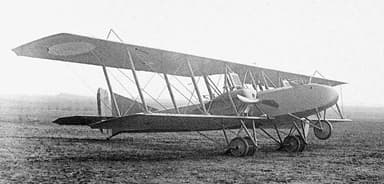
https://en.wikipedia.org/wiki/File:Dugny._Biplan_Letord_-_Fonds_Berthel%C3%A9_-_49Fi653.jpg
The general characteristics of the Letord Let.1 version were:
- Length 37 ft, height 12 ft, wing span 59 ft, wing area 671 sq ft
- Empty weight 3,660 lb, gross weight 5,401 lb, two to three crew
- 2 × Lorraine-Dietrich 8Fb V-8 water-cooled piston engines, 240 hp each
- Max speed 96 mph, service ceiling 15,978 ft, range 217 mi
- 1 or 2 machine guns in nose or dorsal, 660 lb drop load munitions

https://commons.wikimedia.org/w/index.php?search=Letord+Let.1&title=Special:Search&profile=advanced&fulltext=1&advancedSearch-current=%7B%7D&ns0=1&ns6=1&ns12=1&ns14=1&ns100=1&ns106=1#/media/File:245_12_Letord_fran%C3%A7ais_qui_bombarde_en_18.jpg
Siemens-Schuckert D1 Out of Sync with History (November 2016)
Aircraft development was proceeding apace as the second year of the war drew to a close. New innovations such as the French Nieuport 17 fighter were proving a match for their competitors. Accordingly, the German air force sent several captured examples to their own manufacturers. The Siemens-Schuckert D.I was born out of this process.
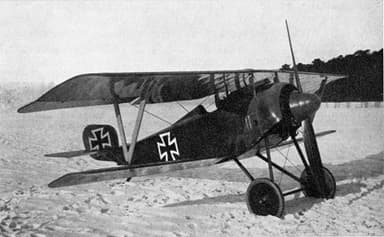
https://en.wikipedia.org/wiki/File:SSW_D.I_in_snow.jpg
The resultant clone adhered very closely to the French specification, with the exception of the motor which became a semi-enclosed Siemens-Halske Sh.I 9-cylinder, 110 hp contra-rotating air-cooled rotary piston engine. The German air force ordered 150 aircraft on 25 November 1916, but delivery was slow.
The main reasons were, apparently production bottlenecks due to technical difficulties with the complicated, geared engines. By the time they were finally available in mid-1917, the very much superior Albatros D.III had superseded them, and they mostly ended their life at fighter training schools.
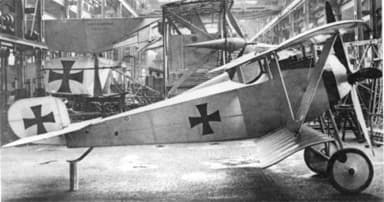
https://www.militaer-wissen.de/siemens-schuckert-d-i/?lang=en
The specification of the Siemens-Schuckert D.I was as follows:
- Length 20 ft, height 8 ft, wing span 25 ft, wing area 155 sq ft
- Empty weight 948 lb, gross weight 1,488 lb, one crew
- Siemens-Halske Sh.I 9-cylinder contra-rotating rotary piston engine 110 hp
- Max speed 96 mph, endurance 2.3 hours, 24 min to 13,000 ft
Large Scale Use of Aluminum in Aircraft Structure (Nov 1916)
The French Bréguet 14 biplane bomber was among the first mass-produced aircraft to use large amounts of aluminum, rather than wood or steel in its structure. The French produced over 8,000 of aeronautical engineer Louis Bréguet’s brainchild, and continued using it for many years after peace returned.
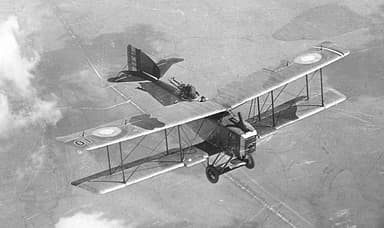
https://en.wikipedia.org/wiki/File:Br%C3%A9guet_14_B.2_in_flight.jpg
The innovative airframe did away with hundreds of pounds of heavier wood, and enabled a fast, agile aircraft able to outrun some contemporary fighters. Beyond that it had a boxy shape – and unusually negatively-back-staggered wings with ailerons on the lower ones.
The first prototype flew on November 3, 1916 when it recorded a speed of 107 mph. Production began in March the following year, and the aircraft took part in a number of battles on the Western Front. It also featured in Brazilian, Chinese, Czech, Danish, Finnish, Greek, Japanese, Siamese, Uruguayan, Spanish, and Polish air forces.
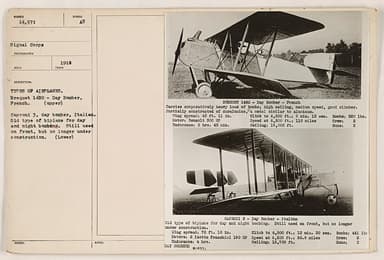
https://commons.wikimedia.org/wiki/File:Br%C3%A9guet_14_B.2_and_Caproni_Ca.3_111-SC-14971_-_NARA_-_55190050.jpg
The original specification of the Bréguet 14 was as follows:
- Length 29 ft, height 11 ft, wing span 14 ft, wing area 530 ft
- Empty weight 2,242 lb, gross weight 3,900 lb, crew two
- Renault 12Fcx V-12 water-cooled piston engine, 300 hp
- Max speed 121 mph, endurance 2.75 hours, service ceiling 20,300 ft
- Rate of climb 958 ft / min, 9 min to 6,600 ft, 16 min to 9,800 ft
- Vickers machine gun plus two Lewis guns, bomb load 783 lb
High Speed Becomes the Path to Air Superiority (Nov 1916)
Germany gained control over the skies after it fitted synchronization gear to its Fokker Eindeckers in November 1915, enabling them to fire forward through a spinning propeller. The Allies put themselves on the path to regaining superiority a year later, when a British Royal Aircraft Factory S.E.5 first flew on November 22, 1916 with a potential top speed of 138 mph.

https://en.wikipedia.org/wiki/File:Royal_Aircraft_Factory_SE5a.jpg
The Royal Aircraft Factory S.E.5 became one of the fastest aircraft of the war, while being both stable and relatively maneuverable, although it responded less immediately to the controls. Beyond that, it was a conventional tractor-engine aircraft, with wire-braced box girder structure, and wings furnished with wooden spars and internal ribs.
The fuselage was narrower providing all-round visibility. The S.E.5 also benefited from considerable structural strength able to withstand high g-force maneuvers. Finally, it was relatively resistant to battle-damage, allowing improved crashworthiness and pilot survivability.
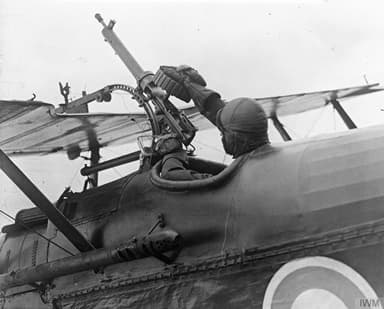
https://en.wikipedia.org/wiki/File:The_Royal_Flying_Corps_on_the_Western_Front,_1914-1918_Q12066.jpg
The S.E.5 entered service in March 1917, although it only arrived on the Western Front a month later. The more powerful S.E.5a followed in June. A British squadron commander described it as ‘comfortable … good all-round view … retains its performance and maneuverability at high level … steady and quick to gather speed in the dive … capable of a very fine zoom … useful in both offence and defense, … strong in design and construction … possessing a reliable engine.
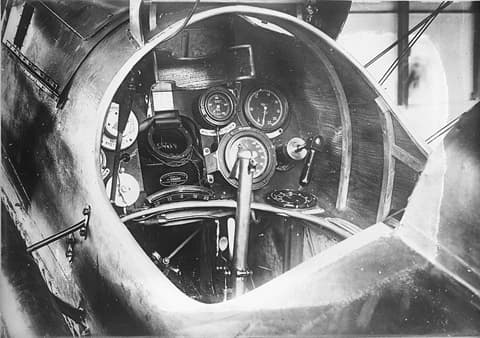
https://en.wikipedia.org/wiki/File:Training_slide_of_Royal_Aircraft_Factory_S.E.5a_cockpit_(17428430695).jpg
The original specification of the Royal Aircraft Factory S.E.5 was as follows:
- Length 21 ft, height 9.5 ft, wing span 26 ft, wing area 244 sq. ft
- Empty weight 1,410 lb, gross weight 1,935 lb, crew one
- Hispano-Suiza 8 or Wolseley Viper water cooled V8 engine, 150 hp
- Max speed 138 mph, range 300 mi, service ceiling 17,000 ft
- .303 inch forward-firing Vickers machine gun with interrupter gear
- .303 inch Lewis gun on Foster mounting on upper wing
- 4x 25 lb Cooper bombs dropped in series, two under each lower wing

https://en.wikipedia.org/wiki/Royal_Aircraft_Factory_S.E.5#/media/File:Royal_Aircraft_Factory_SE5_-_Frame01.jpg
The ‘Best Known Fighter Aircraft’ of the Great War (Dec 1916)
This was quite an accolade if it were true of the Sopwith Camel, which was the name pilots attached to the hump-shaped protective covering over its machine guns. Some 4,490 were produced, and these went down in history as having shot down 1,294 enemy aircraft between them.

https://en.wikipedia.org/wiki/File:RAF_Sopwith_Camel.jpg
Development commenced in 1916, when it became clear the Sopwith Pup was no match for newer German fighters such as the Albatros D.III. The biplane design followed generally accepted principles, with a wood frame, single rotary engine and twin machine guns at the business end. The maiden flight was on December 22, 1916, and from there the project went from strength to strength.
Aerial dogfights between competing aircraft were relatively low-speed, low-altitude affairs. The Sopwith Camel was difficult to handle. But it soon came into its own in the hands of experienced pilots, and performed well in those split-second battles. However, towards the end of the war authorities re-deployed it as a ground-attack aircraft, because new designs coming online generally outclassed it.
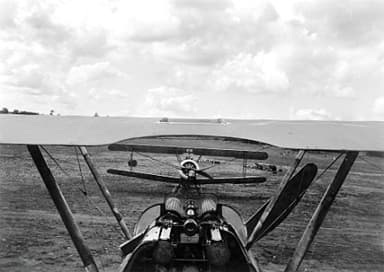
https://en.wikipedia.org/wiki/File:E02659CobbyCamel1918.jpg
The specification of the Sopwith Camel was as follows:
- Length 18 ft, height 8.5 ft, wing span 28 ft, wing area 231 sq ft
- Empty weight 930 lb, gross weight 1,453 lb, crew one
- Clerget 9B 9-cylinder air-cooled rotary piston engine, 130 hp
- Max speed 113 mph, stall 48 mph, range 300 mi, ceiling 19,000 ft
- Rate of climb 1,085 feet per minute, power to mass 0.009 hp per lb
- Two 0.303 in (7.7 mm) Vickers machine guns forward-mounted on fuselage
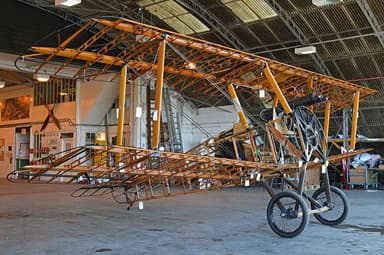
https://en.wikipedia.org/wiki/File:Replica_Sopwith_Camel_(G-BZSC)_(12243203404).jpg
1917
The year saw rapid progress in development of fighter aircraft with fast, powerful motors, and large, multi-engine bombers. German aircraft were distinguished by their advanced designs, while Allied ones were cruder but produced in larger numbers.
Fighter aircraft assumed a vital role over battlefields of Europe. They were eyes-in-the-sky able to spot and report troop movements. And also able to machinegun-strafe enemy troops in trenches.
Much progress was made with using aircraft in tandem with warships. They could fly beyond the horizon and spot enemy ships gathering. They also began exploring using torpedoes and bombs for direct naval attacks. Biplanes remained the norm, but there were exceptions.
Germany Introduces Escorted Surveillance Flights (January 1917)
The Allies adopted a strategy of escorting their slower-moving surveillance aircraft in mid-1916 when German aerial superiority peaked with the first synchronised machine guns. Some sixth months later the tide was turning.
Germany disbanded three bomber wings, and tasked its Albatros L 1 DDK, Rumpler 4A 13, Gotha Taube, and Fokker M.8 aircraft with escort duties. Their primary role was to glean information on Allied movements on the ground.
First Airplane Designed for Carrier Operations (February 1917)
Landing and taking off from ships was an ad hoc affair, prior to the first flight of the British Fairey Campania biplane-seaplane on February 16, 1917. She was a dual purpose, shipborne patrol and reconnaissance aircraft that did service in the First World, and Russian Civil Wars.
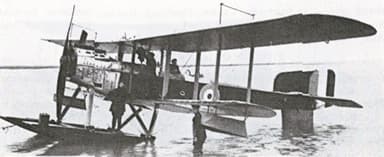
https://en.wikipedia.org/wiki/File:Fairey_Campania.jpg
The single engine, two seat biplane benefited from two main floats, and backward folding wings for storage in cramped conditions onboard. She was initially designed to work with the converted passenger liner Campania, turned into a seaplane carrier in mid-1916. The crew sat in separate cockpits, with the rear observer operating a machine gun mounted on a self-compensating ring.
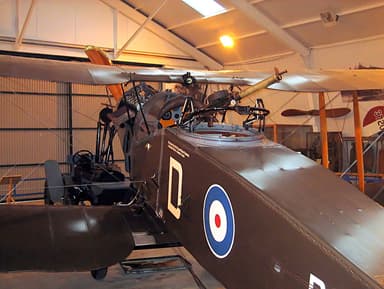
https://en.wikipedia.org/wiki/Scarff_ring#/media/File:Scarff_ring_sc.jpg
The British Navy based 27 Fairey Campania biplane-seaplanes on three carriers, namely HMS Campania, HMS Nairana and HMS Pegasus. However, only Campania had a flight deck for seaplanes using wheeled bogies fitted to the main floats, but able to jettison. The other two launched and recovered their seaplanes from the surface of the ocean.
The aircraft had a successful, if not spectacular career operating from naval air stations. It proved a useful spotter aircraft and took part in the Russian Civil War, when it combined with naval and ground military to persuade rebels to retreat from their fortifications.

http://flyingmachines.ru/Site2/Crafts/Craft34722.htm
The initial specification of the Fairey Campania was as follows:
- Length 43 ft, height 15 ft, wing span 61.5 ft, wing area 674 sq ft
- Empty weight 3,672 lb, gross weight 5,329 lb, crew two
- Sunbeam Maori II V-12 water-cooled piston engine, 260 hp
- Max speed 85 mph, endurance 4.6 hrs, ceiling 6,000 ft,
- One .303 inch Lewis machine gun on Scarff ring in rear cockpit
- Up to six, 116 bombs positioned under wings and fuselage
Austro-Hungarian Service Adopts First Local Fighter (March 1917)
The Austro-Hungarian air service used German aircraft prior to the arrival of the Aviatik (Berg) D.I biplane fighter. It was a local initiative of the Austro-Hungarian branch of German aircraft company Aviatik. However, a number of local subcontractors also manufactured it under license.
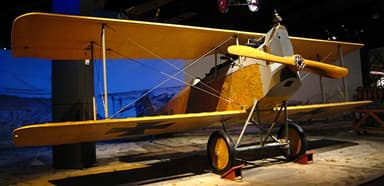
https://en.wikipedia.org/wiki/File:AviatikBergMoFS.JPG
Extensive use of plywood sheets to simplify the task of semi-skilled labor resulted in a product some described as ‘ugly’ and ‘cumbersome’. However, the tide of war was gradually turning to the advantage of the allies, and around 700 of these reasonably fast aircraft saw service in 1917, and 1918.
The specification of the Aviatik D.1 was as follows:
- Length 22.5 ft, height 8 ft, wing span 26 ft, wing area 235 sq ft
- Empty weight 1,345 lb, gross weight 1,878 lb, crew one
- Austro-Daimler 6 water-cooled in-line piston engine, 197 hp
- Max speed 115 mph, endurance 2.5 hrs, ceiling 21,180 ft
- Two fixed 8 mm Schwarzlose MG M.07/12 machine guns
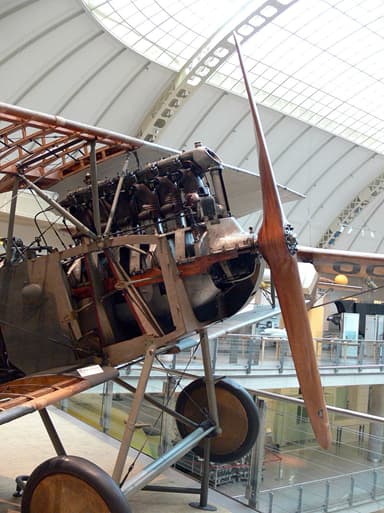
https://en.wikipedia.org/wiki/Austro-Daimler_6#/media/File:TMW_-_Aviatik_D_1_1.jpg
Aerodynamic Calculations Produce a Turn of Speed (March 1917)
The Italian Ansaldo company may have changed the face of aviation science when it set out to design the Ansaldo SVA family of Italian reconnaissance biplane aircraft. That’s because it claimed to have performed the first actual calculations of aerodynamic and structural factors in Italy.
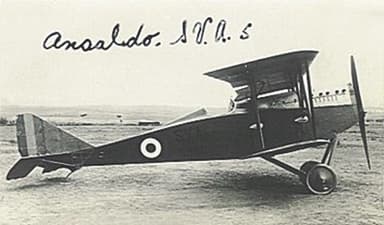
https://en.wikipedia.org/wiki/File:Ansaldo_S.V.A.5.jpg
The SVA was a conventionally laid-out, unequal-span biplane. However, it was unusual in featuring Warren Truss-style diagonal struts joining its two wings, eliminating the need for bracing wires. But it was found to be inadequate for its intended fighter role for reasons that are not clear.
None the less it had an impressive speed, range and operational ceiling. In fact, it was one of the fastest of all Allied combat aircraft of its time. This combination ensured the 1,245 SVA’s were excellent reconnaissance aircraft, and even light bombers.
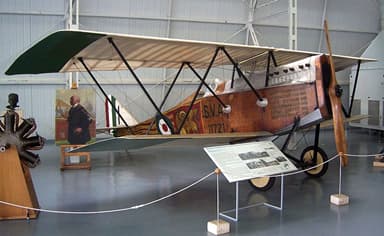
https://en.wikipedia.org/wiki/File:Ansaldo_SVA_5_2009-06-06.jpg
The specification of the Ansaldo SVA was as follows:
- Length 26.5 ft, height 8.5 ft, wing span 30 ft, wing area 260 sq ft
- Empty weight 1,499 lb, gross weight 2,315 lb, crew one
- SPA 6A 6-cylinder water-cooled in-line piston engine, 200 hp
- Max speed 140 mph, range 430 mi, endurance 3 hours
- Service ceiling 20,000 ft, rate of climb 980 ft per minute
- Two synchronized .303 inch Vickers machine guns, 200 lb of bombs

https://en.wikipedia.org/wiki/SPA_6A#/media/File:SPA_6A_inline_engine_(2).JPG
The Ansaldo A.1 Was Not the Best Fighter but It Sold (March 1917)
The Ansaldo A.1 ‘Balilla’ biplane was born in a patriotic moment. It was Italy’s only domestically-designed fighter aircraft of World War I, to be produced in that country, and performed exhibition flights before adoring partisan crowds. However, the truth was the military probably accepted it because it had an urgent requirement to replace obsolete fighters in service.
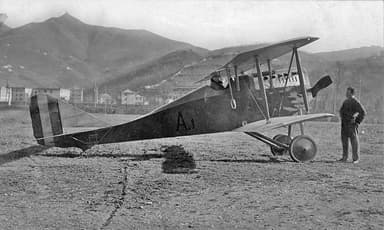
https://en.wikipedia.org/wiki/File:Ansaldo_A.1_Balilla_(1918).jpg
Some 250 Ansaldo A.1 Balilla’s sold, many of them after the war in 1919-1921 for the Polish-Soviet conflict. It was an attempt to improve on the Ansaldo SVA.5 which failed to impress as a fighter. However, Italian pilots still preferred the French Macchi Nieuport 17 for its greater maneuverability.
Ansaldo went back to the drawing board, and returned with a version with slightly enlarged rudder and wings, and 10% more power. The Italian military ordered this A.1bis version, despite pilots still objecting it was too un-maneuverable and difficult to fly.
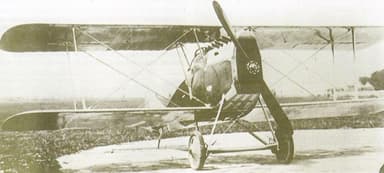
Link to Image
The general specification of the Ansaldo A.1 was as follows:
- Length 22.5 ft, height 8.5 ft, wing span 25 ft, wing area 228 sq ft
- Empty weight 1,410 lb, gross weight 1,950 lb, crew one
- SPA 6A 6-cylinder water-cooled in-line piston engine, 220 hp
- Max speed 140 mph, range 410 mi, ceiling 16,400 ft, 520 ft per min
- Two synchronized .303 inch Vickers machine guns
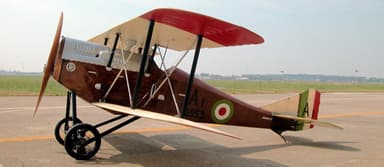
First Close Aerial Support for Troops on the Ground (April 1917)
The war continued much as before, with aircraft used in bombing and surveillance raids, and scouting for submarines and other naval vessels out to sea. Then on April, 24, 1917 the commanding officer of a German fighter escort squadron changed the rules of engagement.

https://en.wikipedia.org/wiki/File:Halberstadt_CL_II_WW1_aircraft_left.jpg
He zoomed down to an altitude of around 60 feet in his Halberstadt CL.II, two-seater aircraft, and sprayed 500 rounds of ammunition into British trenches to support advancing German ground troops. Hundreds of enemy rifles and machine guns turned on him, damaging the engine and forcing him to withdraw.
The specification of the Halberstadt CL.11 was as follows:
- Length 24 ft, height 9 ft, wingspan 35 ft, wing area 296 sq ft
- Empty weight 1,704 lb, gross weight 2,498 lb, crew two
- Mercedes D.III 6-cylinder water-cooled in-line piston engine, 160 hp
- Max speed 103 mph, endurance 3 hrs, ceiling 16,700 ft
- 3,300 ft in five minutes. 16,000 ft in forty minutes
- 7.92 mm LMG 08/15 “Spandau” machine gun, synchronized
- 7.92 mm Parabellum MG14 machine gun, on ring mount for observer
- 10 stick grenades, up to five 22 lb trench mortar fragmentation bombs
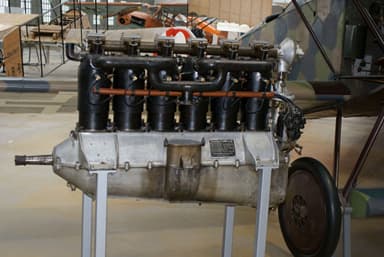
https://en.wikipedia.org/wiki/Mercedes_D.III#/media/File:Daimler_D.III_LSide_DMFO_10June2013_(14606972403).jpg
British Aircraft Commence Spider Web Patrols at Sea (April 1917)
German submarines continued to harass shipping in the North Sea, including traversing the Hinder Shoal between Antwerp in Belgium, and the River Thames leading to London. The British air force began ‘spider patrols’ over the area using Felixstowe F.2A flying boats on April 13, 1917.
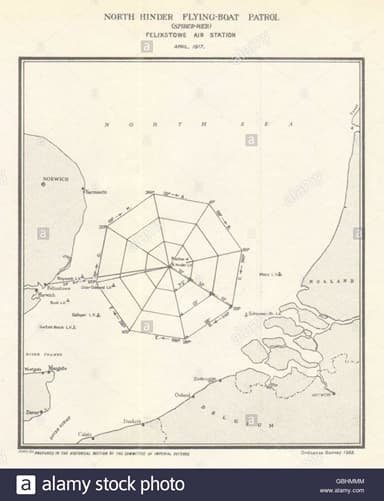
https://www.alamy.com/stock-photo-first-world-war-nhinder-flying-boat-patrol-spiderweb-1917-felixstowe-110412868.html
This was a new patrol pattern in which four aircraft could search 4,000 square miles in eight hours, which was just half the time the submarines took to traverse the area. The Felixstowe F.2A flying boats spotted eight German submarines during twenty-seven patrols over eighteen days, and made bombing attacks against three.
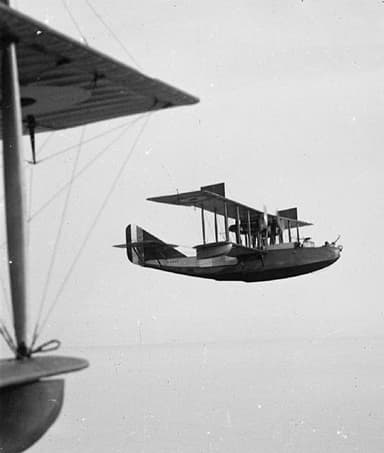
https://en.wikipedia.org/wiki/File:Felixstowe_F2.jpg
The specification of the Felixstowe F.2A was as follows:
- Length 46 ft, height 17,5 ft, wing span 95.5 ft, wing area 1,133 sq ft
- Empty weight 7,549 lb, gross weight 10,978 lb, crew four
- 2 × Rolls-Royce Eagle VIII V12 piston engines, 345 hp
- Max speed 95.5 mph, endurance 6 hours, ceiling 9,600 ft, 4 min to 2,000 ft
- 4 × .303 in Lewis Guns, 1 in nose, 3 amidships, 460 lb bomb load
The Simple, But Hugely Successful SPAD S.XIII (April 1917)
French aircraft manufacturer Société Pour L’Aviation et ses Dérivés (SPAD) needed a successor for their range, as Germany kept piling on new innovations. Their answer was the basic biplane fighter SPAD.XIII that performed the role successfully. By the time production ended the company had sold a staggering 8,472 of the little airplanes.
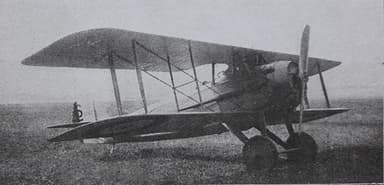
https://commons.wikimedia.org/w/index.php?search=SPAD.XIII&title=Special%3ASearch&go=Go&ns0=1&ns6=1&ns12=1&ns14=1&ns100=1&ns106=1#/media/File:SPAD_XIII_my%C5%9Bliwski_franc.jpg
The SPAD X.III used a powerful new, geared version of the successful Hispano-Suiza 8A engine. Pilots may not have approved of the cannon armament, but it went down in history as one of the most capable fighters of the war. A further 10,000 were on order when Armistice came.
Every French squadron was using them by the end of World War I, while the United States was also deploying them in bulk. But what made them special? They did not have a good reputation for reliability, were not particularly maneuverable, and were difficult to control at low speeds.
However they were faster than the British Sopwith Camel and the German Fokker D.VII, and that made a deal of difference when every bullet seemed meant for you.
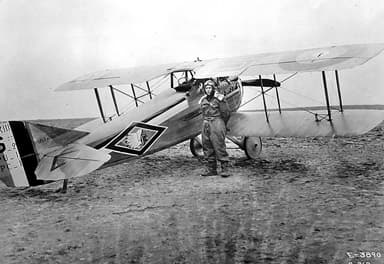
https://en.wikipedia.org/wiki/File:103rd_Aero_Squadron_-_Spad_XIII.jpg
The specification of the SPAD S.XIII was as follows:
- Length 20 ft, height 8.5 ft, wing span 27 ft, wing area 227 sq ft
- Empty weight 1,326 lb, gross weight 1,888 lb, crew one
- Hispano-Suiza 8 Water cooled 8-cylinder vee-type, 200 hp
- Max speed 131 mph, endurance 2 hrs, ceiling 22,300 ft, 2 min to 3,300 ft
- Two Vickers, Marlin M1917, or M1918 machine guns, four 25 lb bombs

https://en.wikipedia.org/wiki/Hispano-Suiza_8#/media/File:Hispano_Suiza_8_A_Brussel.jpg
German Bombers Begin to Take Over from Zeppelins (May 1917)
Kaiser Wilhelm II of Germany recommended redeploying zeppelins for deep sea reconnaissance following limited success during air raids on Britain. The chief of navy staff resisted this, and the raids continued.
However, on May 25, 1917 Germany appeared to change direction during Operation Türkenkreuz (Turk’s Cross), a heavier-than-air bombing campaign also targeting London. The opening gambit was a mass air raid by 21 Gotha G.IV bombers arriving from Belgium.
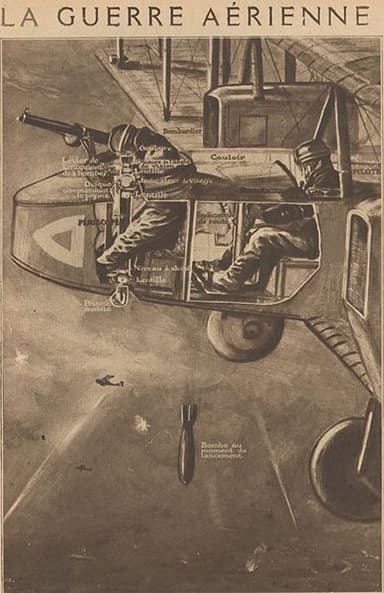
https://en.wikipedia.org/wiki/File:Gotha_G.jpg
The squadron had to divert to secondary coastal towns because of heavy clouds over the capital city, but secured some success. Nine British Sopwith Pups engaged the bombers on their way back to base, and shot one Gotha G.IV bomber down. A further 21 German heavier-than-air raids on Britain followed.
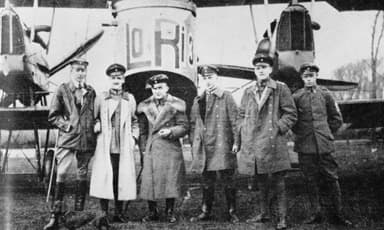
https://en.wikipedia.org/wiki/German_strategic_bombing_during_World_War_I#/media/File:Gotha_and_crew.jpg
The Popular U.S. Trainer Thomas Morse S.4 Scout (June 1917)
Pilot training got off to a shaky start at the beginning of the war, with aging aircraft and the imperative to get pilots into planes foremost. America had the advantage of time on its side as it entered the war gradually. The outcome was better conceived designs, better quality manufacture and more reliable airplanes, of which the Thomas Morse S.4 Scout was a typical example.

https://en.wikipedia.org/wiki/File:Thomas_Morse_S-4c_Scout.jpg
The ‘Tommy’ as pilots called it was a compact single-seat open-cockpit biplane of equal span and a 100 hp rotary engine. It was often the first opportunity for an American pilot to fly alone up into the sky. Every pursuit flying school in the United States had adopted it in 1918.
When the war was over, many Tommy’s found second lives at civilian flying schools, and as recreation vehicles for veteran pilots. They were still appearing in World War 1 aviation movies in the 1930’s, quite an accolade for days when not all aircraft were as reliable.

https://en.wikipedia.org/wiki/File:Thomas-Morse_S-5.jpg
The specification of the Thomas Morse S.4 Scout was as follows:
- Length 20 ft, height 8 ft, wing span 26.5 ft, wing area 234 sq ft
- Empty weight 963 lb, gross weight 1,330 lb, crew one
- Le Rhône 9C nine cylinder, air-cooled rotary 80 hp engine
- Max speed 97 mph, endurance 2.5 hrs, service ceiling 15,000 ft
- Optional .30 caliber M1917/1918 Marlin-Rockwell machine gun
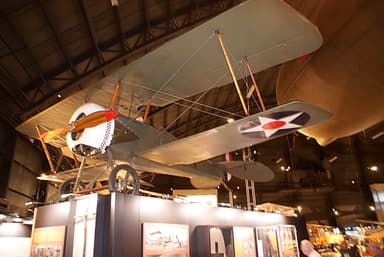
https://en.wikipedia.org/wiki/Thomas-Morse_S-4#/media/File:Thomas-Morse_S4C_Scout_BelowL_light_Early_Years_NMUSAF_25Sep09_(14413222320).jpg
Mixed Fortunes For The Fokker Dr.1 Triplane (June 1917)
The German Fokker Dr.1 triplane was an exceptionally maneuverable aircraft compared to the Albatros and Pfalz fighters that preceded it. The design came about after Anthony Fokker viewed a captured Sopwith Triplane in April 1917. Then he asked Reinhold Platz to build the triplane the Red Baron ace pilot made famous.
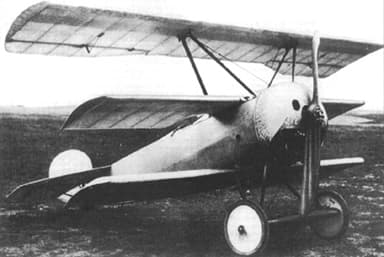
https://en.wikipedia.org/wiki/File:Trprototype.jpg
Reinhold Platz’s first attempt on June 5, 1917 was not a success. However, the V.5 prototype became the Fokker Dr.1 after he introduced horn-balanced ailerons and elevators, as well as longer-span wings. He also added interplane struts to minimize wing flexing before he tested the prototype to destruction.
Fokker built some 320 Fokker Dr.1’s. They were an operational success despite structural wing failures, which saw the range discontinued in May 1918. Red Baron Manfred von Richthofen first flew one on September 1, 1917. He achieved two kills in the first two days despite the notoriously cramped cockpit.
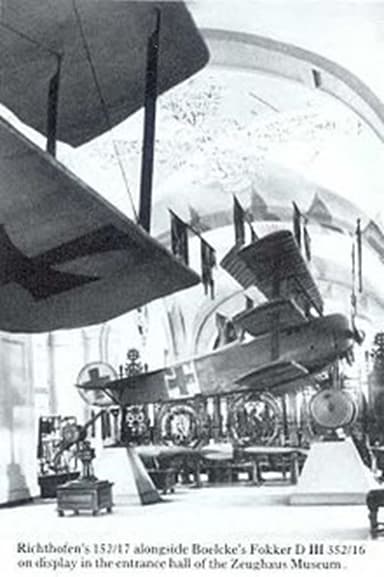
https://en.wikipedia.org/wiki/Fokker_Dr.I#/media/File:Fokker_Dr.I_at_Drzeughaus_(museum).jpg
The specification of the Fokker Dr.1 was as follows:
- Length 18 ft, height 9.5 ft, upper wingspan 23.5 ft, wing area 201 sq ft
- Empty weight 895 lb. gross weight 1,201 lb, crew one
- Oberursel Ur.II 9-cylinder air-cooled rotary piston engine, 110 hp
- Max speed 110 mph, stall speed 45 mph, range 190 mi
- Service ceiling 20,000 ft, rate of climb 1,120 ft per min
- 2 × 0.312 inch Maschinengewehr 08 “Spandau” machine guns
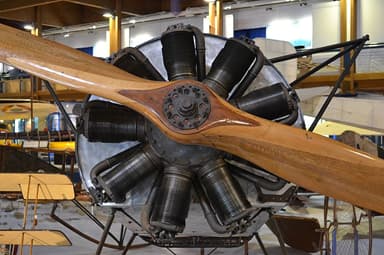
https://commons.wikimedia.org/wiki/File:Oberursel_UR.II.jpg
First Dedicated Torpedo Bomber for Carrier Operations (June 1917)
The Sopwith T.1 Cuckoo was a British biplane torpedo bomber designed with carrier operations in mind. Flight testing began on June 6, 1917, although the end of the war in 1918 removed the naval operation from the program. The military specification was a single-seat aircraft capable of carrying a 1,000 lb torpedo, and with endurance of four hours.
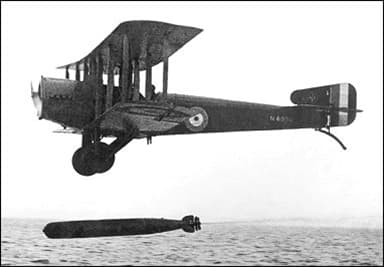
https://en.wikipedia.org/wiki/File:Sopwith_Cuckoo_launching_torpedo.jpg
Sopwith responded with a large, three-bay biplane, with wings hinged to fold back to accommodate carrier operations. It could take off from a carrier at sea in four seconds. However, there was no arrestor gear, so pilots had to return to land, or ditch in water which was generally successful.
The navy promptly confirmed an order for 100 aircraft in August. However, the contractors had no related experience and this substantially delayed production. Deliveries only commenced a year later from another contractor, by which time the war was nearly over.
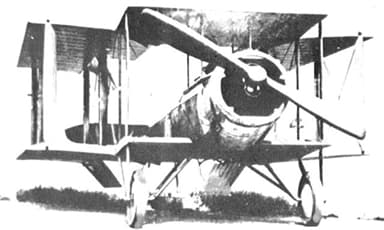
http://flyingmachines.ru/Site2/Crafts/Craft25673.htm
The specification of the Sopwith T.1 Cuckoo was as follows:
- Length 28.5 ft, height 10.5 ft, wing span 46,75 ft, wing area 566 sq ft
- Empty weight 2,199 lb, gross weight 3,883 lb, crew one
- Sunbeam Arab V-8 water-cooled piston engine, 200 hp
- Max speed 105 mph, range 335 mi, ceiling 12,100 ft
- Armament 1× 18 inch Mk.IX torpedo, no mention of machine gun
Fighter Biplane Takes off From Turret of a Battleship (June 1917)
Flight decks added to the foredecks of warships generally put the main armament temporarily out of action. The British light cruiser HMS Yarmouth, launched April 1911 participated in an unusual experiment on June 28, 1916.
A Sopwith Pup with Flight Commander F. J. Rutland at the controls successfully flew off a flight deck mounted atop the warship’s main forward turret. On August 21 he repeated the experience when he took off, attacked and downed Zeppelin L 23 near Bovbjerg, Jutland Denmark.
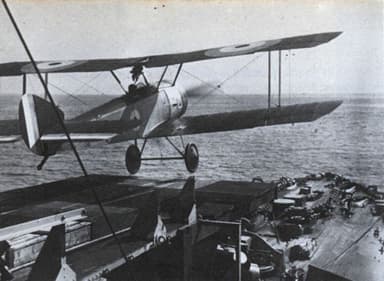
https://en.wikipedia.org/wiki/File:Rutland-yarmouth.jpg
The Fast, Heavy Airco DH.9 Bomber that Survived (July 1917)
Bombing was a dangerous activity in a sky filled with faster enemy fighters, and many of the larger bombers left no survivors intact to preserve. The Airco DH.9 of which 4,091 were made was an exception, because it remained in service until 1937 in military and civilian roles.
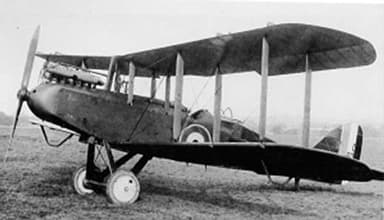
https://en.wikipedia.org/wiki/File:Airco_D.H.9.jpg
The Airco DH.9 mated components from Airco’s successful DH.4 with a new fuselage and the BHP/Galloway Adriatic engine, which promised increased performance. Large advance orders poured in however, the new engine was underpowered resulting in heavy losses on the Western Front.
The engineers had faith in their design which was fundamentally solid, and replaced the unit with the more powerful and reliable American Liberty L-12 engine. This rectified the shortcomings and the highly maneuverable DH.9 re-entered service and proved a great success in many Allied air forces.
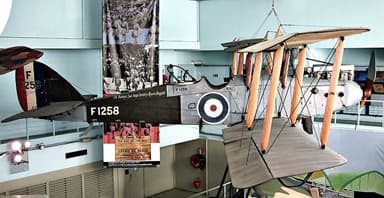
https://en.wikipedia.org/wiki/File:DH.9_F1258_LeB_05.07R.jpg
The specification of the Airco DH.9 was as follows:
- Length 30.5 ft, height 11 ft, wing span 42 ft, wing area 434 sq ft
- Empty weight 2,360 lb, gross weight 3,790 lb, crew two
- Liberty L-12 water cooled, V-12 1,649 cu in 400 hp engine
- Max speed 113 mph, endurance 4 hrs, ceiling 15,500 ft, 18 min / 10,000 ft
- Forward firing Vickers machine gun, 1 or 2 rear Lewis guns
- Up to 460 lb bomb load (original design provided internal storage)
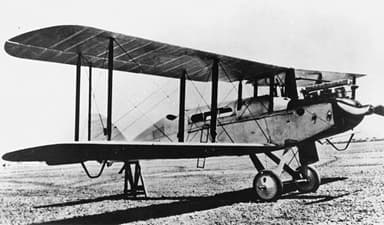
https://en.wikipedia.org/wiki/File:G-AUED.jpg
Imperial German Army Perfects Close Air Support (August 1917)
The Battle of Passchendaele was the third major conflict centering around the Belgian town of Ypres. The herculean struggle was a trench-based stalemate, in which over a half million soldiers were injured or killed. Germany learned how to gain an advantage by attacking open trenches from the air.
Experience taught it’s aircrews the optimum altitude for machine gun and bombing attacks was 150 ft, and line astern formations were best for fending off aerial attacks and reducing the effect of ground fire. Attack formations were groups of four to six aircraft, in forward and support positions.
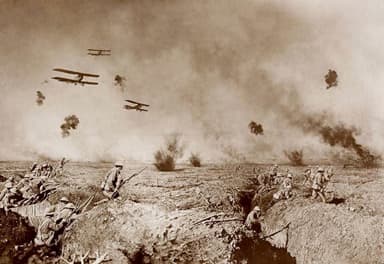
https://www.nytimes.com/2017/11/10/arts/design/ypres-exhibitions-world-war-i.html
First Aircraft Lands Aboard a Moving Ship (August 1917)
HMS Furious was a British battlecruiser modified by the addition of a flight deck ,where her forward main armament would have stood. This alteration was made before commissioning, making her arguably the world’s first purpose-built aircraft carrier.
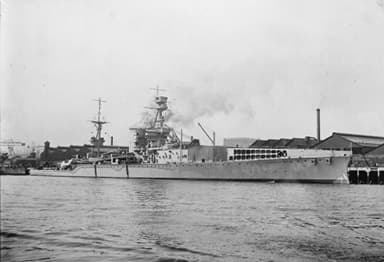
https://en.wikipedia.org/wiki/File:FuriousSP_89.jpg
Squadron Commander Edwin Harris Dunning became the first person to land on a moving ship,on August 2, 1917. His Sopwith Pup performed perfectly, and he was greeted with accolades as he brought her to a stop short of HMS Furious’ bow. A second attempt was also successful.
However, on the third iteration the engine choked, and he crashed off the starboard bow, and was killed. The inquiry concluded the deck arrangement was unsatisfactory, because the aircraft had to maneuver around the superstructure from the stern to land.

https://en.wikipedia.org/wiki/Edwin_Harris_Dunning#/media/File:Dunning_killed_on_second_carrier_landing_IWM_Q_80597.jpg
HMS Furious was modified that November by having her aft turret removed, and replaced by a second deck for landing giving her both launching and recovery capability. She then returned to service and conducted anti-zeppelin patrols for the duration of the war.

https://en.wikipedia.org/wiki/HMS_Furious_(47)#/media/File:HMS_Furious-2.jpg
A New Role for Aircraft as Independent Military Force (August 1917)
Both sides in the conflict had hitherto regarded aircraft as a subsidiary force, serving as auxiliaries to main battle efforts on land and at sea. However, the notable exception continued to be German bombing of Britain, using zeppelins and fixed-wing bombers.
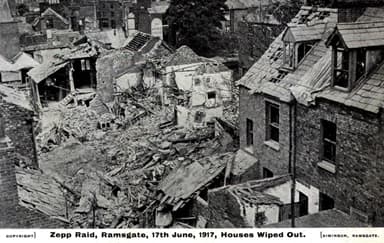
https://www.visitthanet.co.uk/visit-thanet-blog/thanet-and-the-first-world-war/
On August 17, 1917 defense minister for the Union Defence Force predicted this new approach would become the norm in future. He foresaw the main front shifting from direct points of contact, to industrial and communication pivot points supplying armament and munitions from home bases.
Aircraft Launched from Ship Downs Zeppelin (August 1917)
On August 21, 1917 a Royal Naval Air Service pilot flew from a platform on the gun turret of light cruiser HMS Yarmouth. This was not the first occasion. However, it did herald the first successful sea-borne aerial attack that followed.
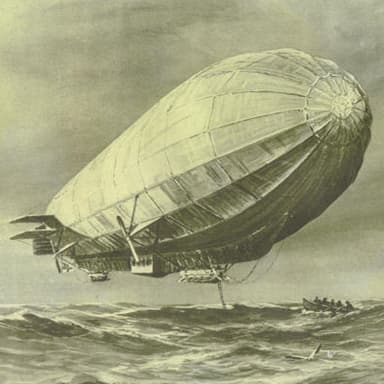
https://commons.wikimedia.org/wiki/File:Zeppelin_Square_Cut.png
The pilot homed in on German Navy Zeppelin L 23, and brought her down in flames in the North Sea. His next problem was returning to his ship, for there was no rear, landing deck back then.
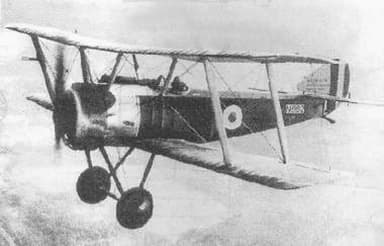
https://en.wikipedia.org/wiki/Sopwith_Pup#/media/File:SopPup2.jpg
He managed to ditch in the water without cartwheeling, and was rescued from his Sopwith Pup fighter tailplane, along with the engine and one of the machine guns.
Junkers J 7 Prototype First All-Metal Fighter in Service (Sept 1917)
The Junkers J 7 was a private venture by Hugo Junkers who first flew the experimental all-metal monoplane fighter on September 17, 1917. It went through a number of iterations until the aircraft engineer-entrepreneur was satisfied.
The German military ordered a batch of 12 airplanes designated J 9 / D.1. But they lacked the maneuverability necessary for front-line fighters, and served their time with a naval unit instead.
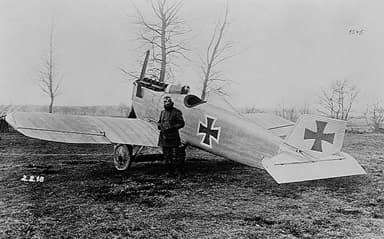
https://en.wikipedia.org/wiki/File:Junkers_J_7_-_Ray_Wagner_Collection_Image_(20818567523).jpg
The aircraft was still not a military success, because pilots found it ‘inconvenient’ with blind spots in its maneuvering capability. However, 47 J 9’s were built after the war, when they proved useful protecting the eastern front from Soviet incursions.
The specification of the Junkers J 7 / D.1 was as follows:
- Length, 23.5 ft, height 8.5 ft, wing span 29.5 ft
- Empty weight 1,438 lb, gross weight 1,834 lb, crew one
- BMW IIIa water-cooled 6-cylinder inline engine 185 hp
- Max speed 109 mph, endurance 1.5 hrs, ceiling 16,700 ft, 683 ft per min
- Two fixed, forward-firing Spandau machine guns
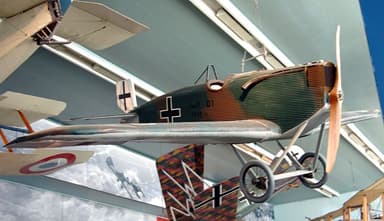
https://en.wikipedia.org/wiki/File:Junkers_D.I_(MAE).JPG
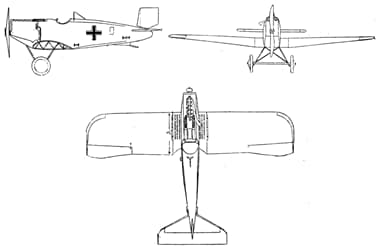
https://en.wikipedia.org/wiki/Junkers_D.I#/media/File:Junkers_D.I_3-view_L’Aerophile_March,1921.png
The Fairey III Reconnaissance Biplane Family (September 1917)
Many new aircraft designs failed to pass their prototype stage during this period. They were either below spec, or arrived too late to reach production before another aircraft superseded them or peace returned. The Fairey III landplane and seaplane biplanes made it through the process and 964 were built.

https://en.wikipedia.org/wiki/File:HMS_Furious-18.jpg
The Fairey III was a two-bay biplane with folding wings. It first flew in Kent, England on September 14, 1917, and had either a wheeled or skid undercarriage, or floatplane gear. The aircraft continued service after the war, and later had an all-metal fuselage and wings.
There were also civilian, peacetime versions with enlarged rear cockpits for four passengers. One competed in a multi aircraft round-the-world flight in 1922, but was lost with all crew saved. A small number saw service performing survey duties in the 1920s and 30s.
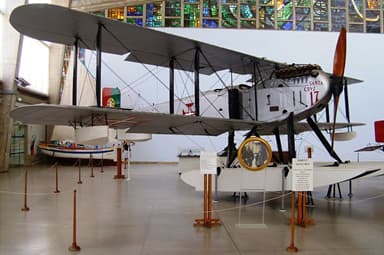
https://en.wikipedia.org/wiki/File:Fairey_F_III-D_n%C2%BA_17_Santa_Cruz.JPG
The general characteristics of the Fairey III were as follows:
- Length 34.5 ft, height 12.5 ft, wing span 45.5 ft, wing area 439 sq ft
- Empty weight 3,855 lb, gross weight 6,041 lb, crew two to three
- Napier Lion XI W-12 water-cooled piston engine, 570 hp
- Max speed 120 mph, range 1,520 mi, ceiling 20,000 ft, 833 feet per second
- Forward firing .303 inch Vickers machine gun, .303 Lewis gun for observer
- Up to 500 lb weight of bombs could be carried under the lower wings
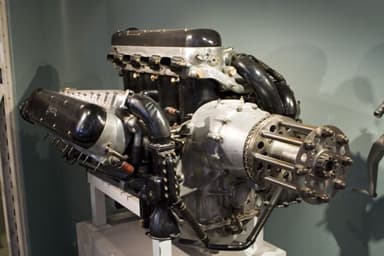
https://en.wikipedia.org/wiki/Napier_Lion#/media/File:CASM_-_Napier_Lion_II_-_030906.jpg
Weather Shields England From German Bombing (Late 1917)
The battle in Europe became an increasingly desperate stalemate, as European nations slugged it out on the ground. However, aircraft were still largely a side-show, where heavy artillery dominated and machine guns withered attempts to break out.
Southern England continued to be the exception where Operation Türkenkreuz continued unabated, with German Gotha G.IV bombers and high altitude zeppelin dirigibles pounding those below from high above.

https://en.wikipedia.org/wiki/German_strategic_bombing_during_World_War_I#/media/File:Gotha_RG_im_Flug.jpg
British fighter aircraft may have had their small successes, but these were as inadequate as aircraft guns literally wearing their barrels out. Britain’s savior was its unpredictable weather, which brought down sufficient aircraft to keep the attackers at bay.
Germany Introduces Aerial Weather Forecasting (Early Dec 1917)
German bombing over Southern England ceased in November 1917, because of the toll heavy weather took on its aircraft. In early December it began operating a radio-equipped Rumpler C.IV biplane off the coast of England, to report weather conditions.
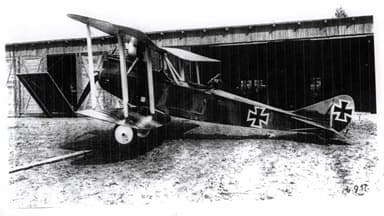
https://en.wikipedia.org/wiki/File:Rumpler_C.IV.jpg
Nineteen heavy bombers and two zeppelins headed out across the Channel on December 5, 1917, when the weather cleared as predicted. The attack comprised a series of waves. However the damage was more emotional than strategic on the ground.
The specification of the Rumpler C.IV was as follows:
- Length 27.5 ft, height 10.5 ft, wing span 41.5 ft, wing area 361 sq ft
- Empty weight 2,381 lb, gross weight 3,373 lb, pilot and observer
- Mercedes D.IVa 6-cylinder water-cooled in-line piston engine, 260 hp
- Max speed 106 mph, endurance 3 to 4 hours, ceiling 21,000 ft
- Fixed, forward-firing .312 inch LMG 08/15 machine gun with an interrupter gear
- Parabellum MG14 .312 inch machine gun on a ring mounting, 220 lb bombs

https://en.wikipedia.org/wiki/File:Rumpler_C_IV_2.jpg
The Biplane Fighter Almost Too Stable for Combat (Dec 1917)
The Phönix D.I and its successors DII and D.III was an Austro-Hungarian fighter that was almost ‘too good for the job’. That’s because pilots complained it was ‘almost too stable for quick combat maneuvers’ meaning presumably it could not outwit its enemy with an unexpected move.

https://en.wikipedia.org/wiki/File:Ph%C3%B6nix_D.I_228.45.jpg
That said, the Phönix Flugzeug-Werke did build 158 of the little fighters that also served in short-range reconnaissance, bombing, defense and artillery-spotting roles. They often worked in formations of four to five aircraft in self-defensive collaboration. The general specification of the Phönix D series was as follows:
- Length 22 ft, height 9 ft, wing span 32 ft, gross weight 1,775 lb, crew one
- Hiero 6 six-cylinder water-cooled in-line piston engine, 200 hp
- Max speed 110 mph, service ceiling 20,000 ft
- Two synchronized fixed forward-firing 0.315 inch machine guns
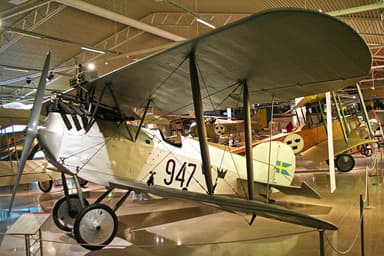
https://en.wikipedia.org/wiki/Ph%C3%B6nix_D.I#/media/File:Phonix_Jagaren_122_D.III_(J-1)_947_(7715857820).jpg
The Junkers J8 / CL.I All Metal Fighter Aircraft (December 1917)
Hugo Junkers became increasingly convinced all-metal monoplanes were where the future of aviation lay. When Germany requested another biplane design, he responded with the prototype Junkers J.8 which became the Junkers CL.I.

https://www.militaryimages.net/media/junkers-c-l-1.8973/
The military were sufficiently impressed to order 51 of the then-revolutionary aircraft, of which 3 were seaplanes. It had a metal framework that was skinned with corrugated duralumin sheets. The prototype first flew on December 10, 1917. One or two survivors converted for commercial service, by enclosing the rear cockpit under a canopy after the war ended.
The general specification of the J.8 / 9 / 10 / CL.I was as follows:
- Length 26 ft, height 8.5 ft, wing span 39.5 ft, wing area 253 sq ft
- Empty weight 1,562 lb, gross weight 2,310 lb, crew pilot and gunner
- Mercedes D.IIIa six cylinder inline SOHC engine, 180 hp
- Max speed 100 mph, endurance 2 hrs, service ceiling 19,700 ft
- Two fixed, forward-firing machine guns, one trainable rear one
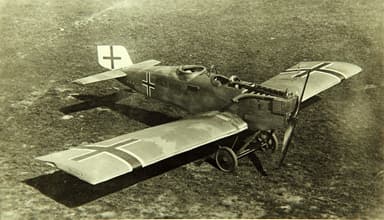
https://commons.wikimedia.org/wiki/Category:Junkers_CL.I#/media/File:Junkers_J_10.jpg
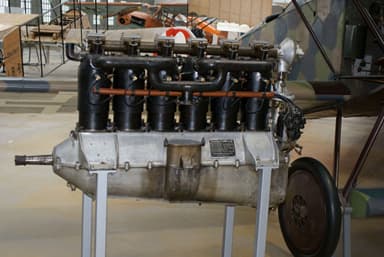
https://en.wikipedia.org/wiki/Mercedes_D.III#/media/File:Daimler_D.III_LSide_DMFO_10June2013_(14606972403).jpg





